- SELF-TIMERS
- FLASH GEAR
- TYPES OF LENSES
- FILTERS
- DARKROOM EQUIPMENT
- PROJECTORS & VIEWERS
- TRIPODS
- MISCELLANEOUS
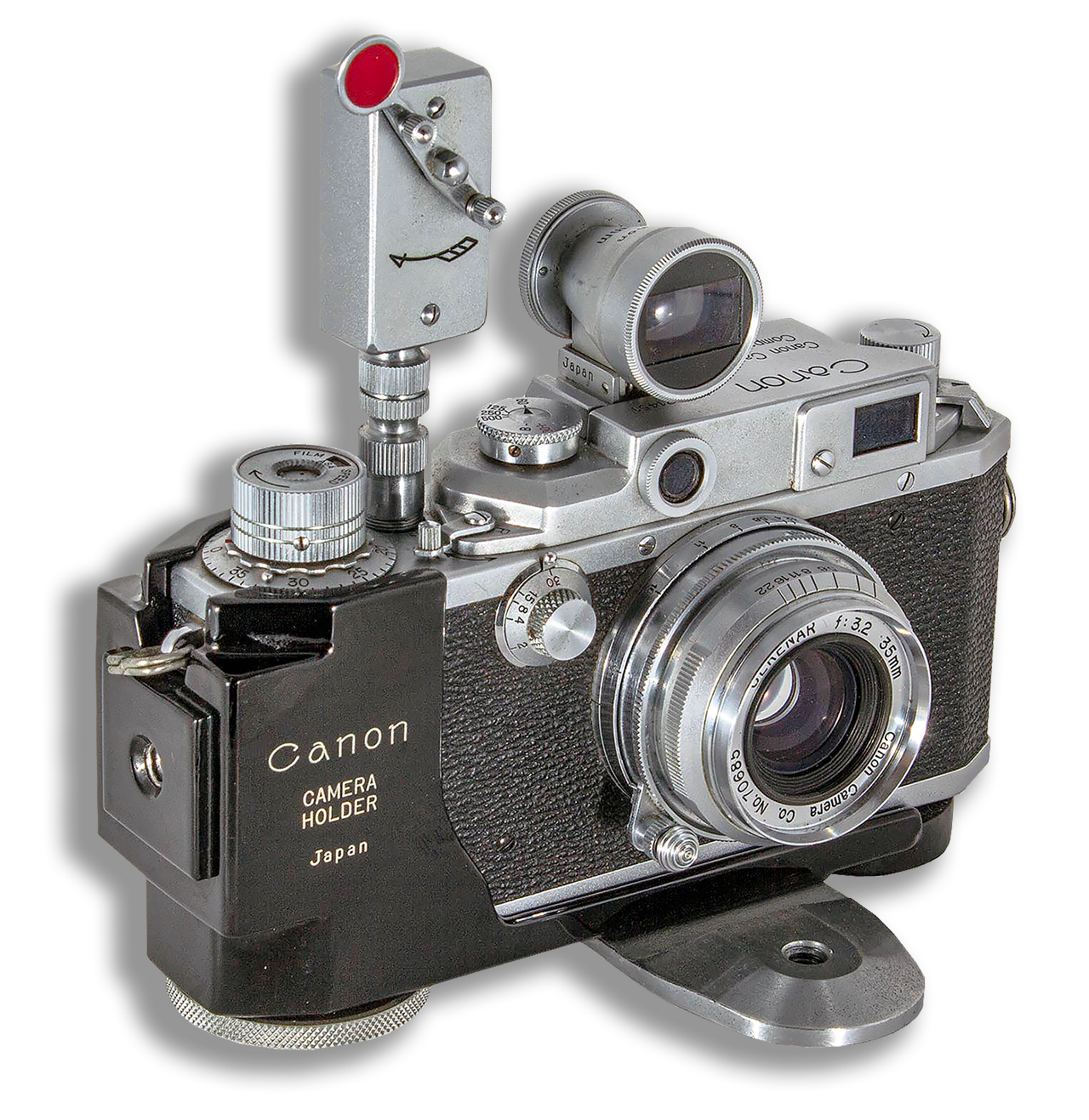
“Autotimer” shutter release for self-portraiture
An ingenious and reliable instrument that releases the shutter for you 15 seconds after it is set in motion. Enables you to include yourself in group pictures. It’s reliable and simple to use. Handsomely finished and nickel-plated execution.
Here a Canon Self-Timer II screwed in the camera shutter release button of a Canon Model II D2 camera, which will allow up to a 10 second delay in the shutter firing. The red circle on the arm rotates with the timing function giving a visual clue as to how long it is till the shutter releases, much like the flashing light on more modern cameras.

Self-timers are commonly used in three situations:
- A self-timer allows the photographer to take a position when taking group photos so that he or she can be taken into the picture;
- If you are traveling alone, you can – e.g. B. under the summit cross — take photos yourself;
- A self-timer can be used to avoid shaky shots at longer focal lengths and exposure times when a remote shutter release is not available. Pressing the shutter button may cause the camera to shake or vibrate for the first 1-2 seconds, even on a tripod. The delayed release leaves enough time for the camera vibrations to subside.
Self-timers usually come from Europe, USA or Japan. A few originated somewhere else or were at least offered exclusively in other countries.
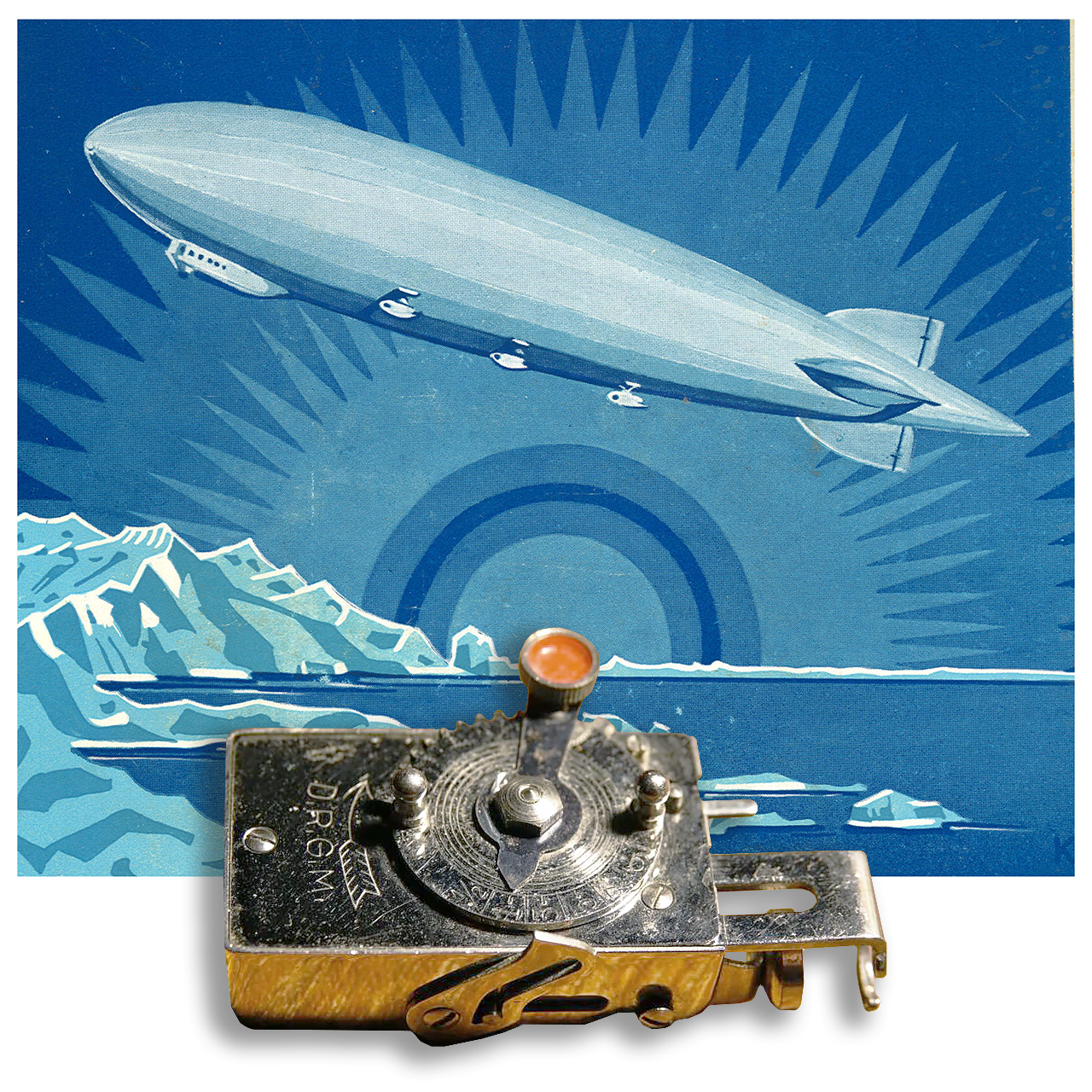
Arctic journey of the airship “Graf Zeppelin”
An example of the fact that self-timers could also be used for purposes other than photographic is this example in the collection of the Museum-digital Brandenburg.
The mechanism was developed as a self-timer for cameras. A small clockwork with an adjustable running time of up to around 8 seconds was used to open the lens shutter with a small Bowden cable on the camera.
During the Arctic voyage of the airship “Graf Zeppelin”, LZ 127, in July 1931, such devices were used to cut off the weight when the radiosondes were launched, which had to take place under the airship. The weights were necessary to override the buoyancy of the radiosonde balloon until the airship was no longer at the launch point, so that the balloon could rise unhindered. The Graf Zeppelin made 590 flights, of which 144 were transoceanic, between 1928 and 1937.
Operation of the clockwork self-timers
A self timer is a device on a camera that gives a delay between pressing the shutter release and the shutter’s firing. Apart from Delayed-Action Self-Timers that work with air pumps, hourglasses, brake rubbers and fuses or work with oil, glycerin or silicone paste, there are two forms of Delayed-Action Self-Timers that work with a clockwork mechanism. These are the most important, most widely produced and used form of self-timers from the last century. They all operate just like a common oven timer: you turn the dial or arm through 180 degrees, there is a stop device to hold it, and when you press the button or move the lever, the mechanism counts down till action.
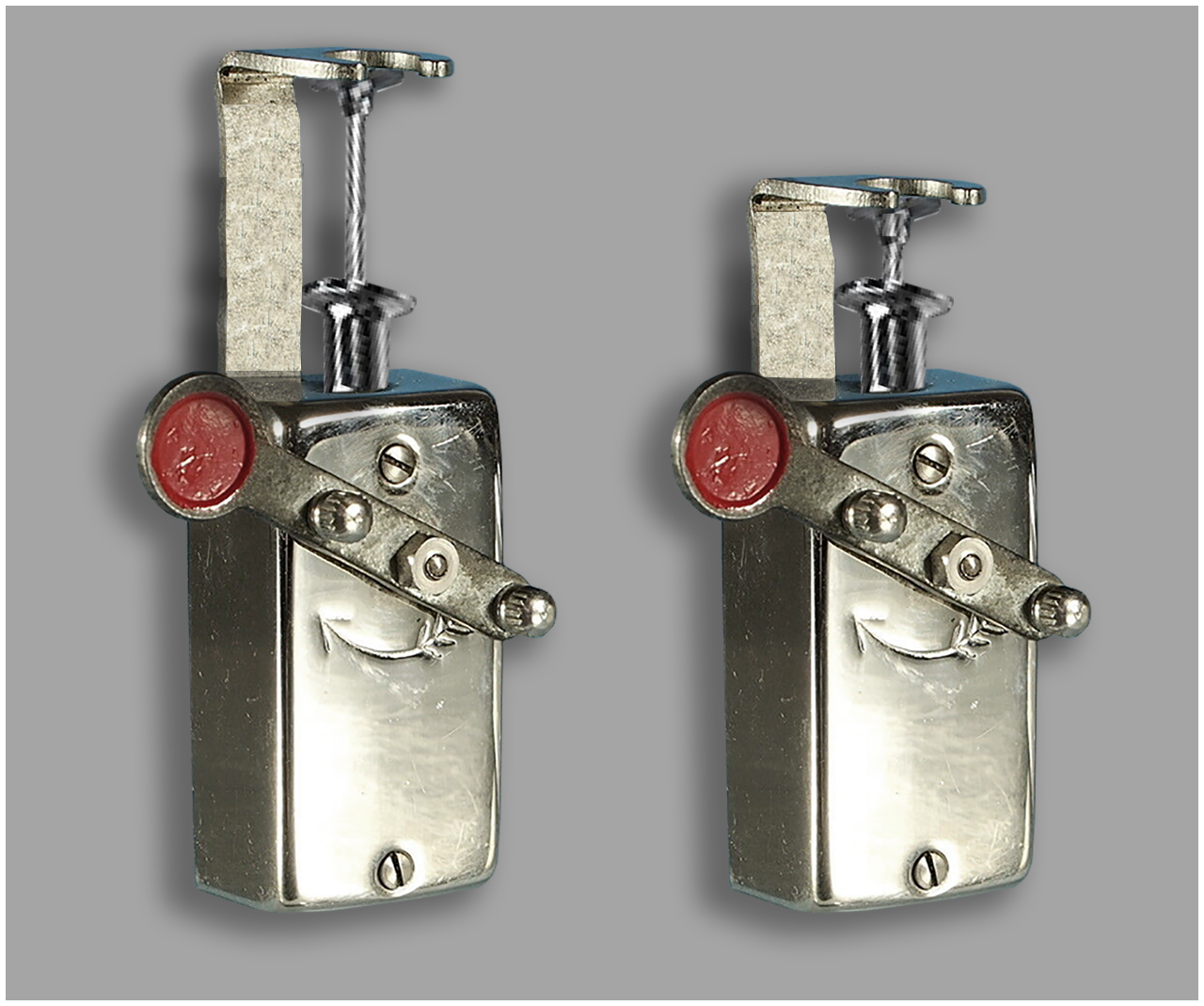
The first type clamps the control handle of the cable release under a bracket. When turning back the spring mechanism of the self-timer, the clamping bracket presses the cable release down, after which the camera shutter is activated when it reaches the fully depressed position.
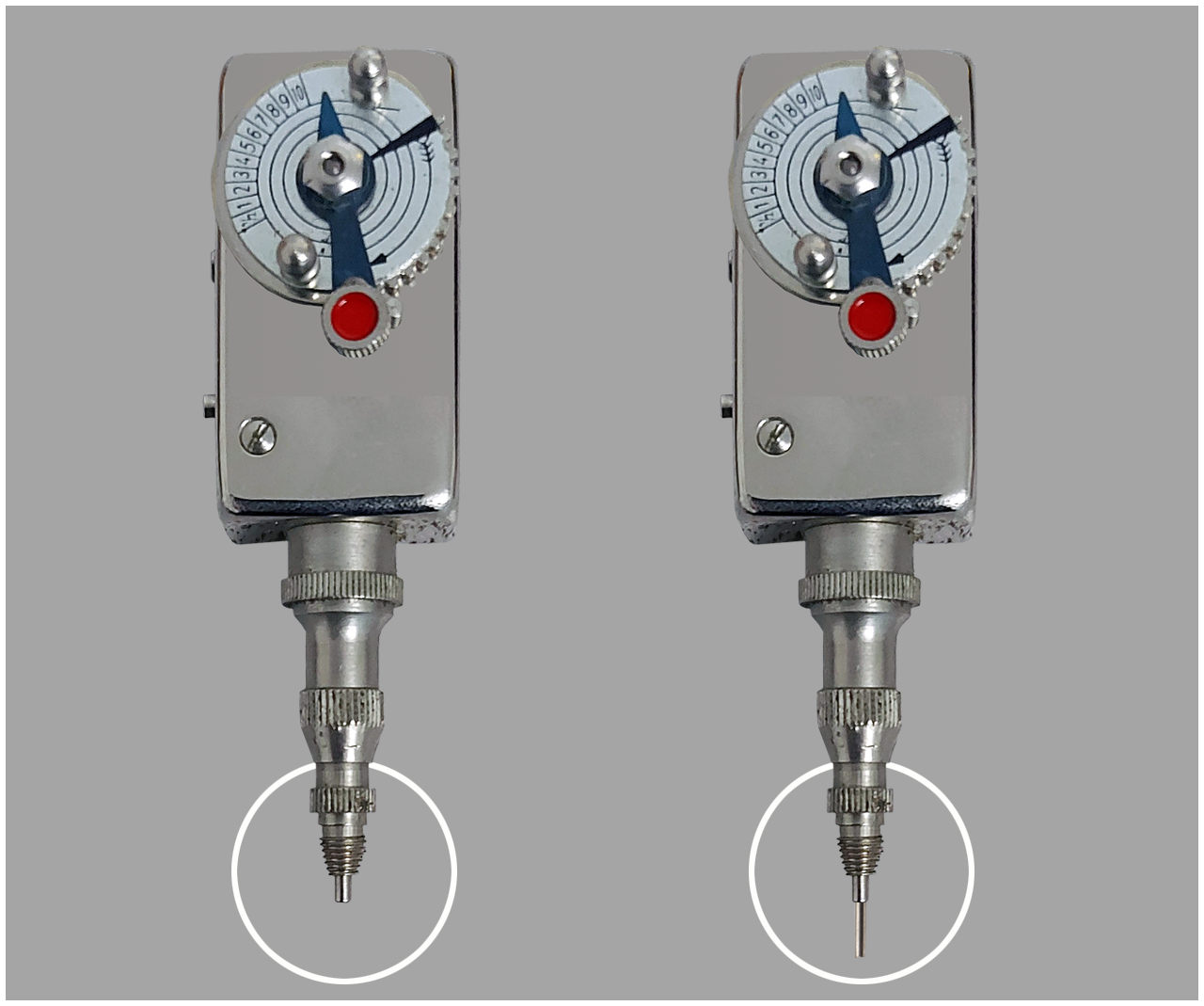
The second type of Delayed-Action Self-Timer is screwed into or on the hole with the tapered thread in the center of the shutter button. After reaching the end position (i.e. after turning back the spring mechanism of the self-timer) a plunger protudes from the bottom of the self-timer and depresses the shutter button.
While cameras nowadays have an integrated self-timer function as a matter of course, there has been a long and interesting development up to this point. Inventors and technicians were on a real hunt for an ideal mechanism to get the photographer himself in front of the lens. No construction seemed too strange: In addition to clockworks, air pumps, hourglasses, brake rubbers and fuses were used, as were hydraulic escapements with oil, glycerin or silicone paste.
Delayed action devices appeared in the 1900s. Often combined with a slow speed timer. Slow speed attachments appeared in the 1890s in the form of valves for fitting within the tube of a bulb release. Later models using clockwork fitted to the end of a wire release or directly to the cable release socket.
At the beginning of the 20th century, self-timers were also manufactured in Germany. The Ernemann company from Dresden offered a clockwork device “to photograph yourself without outside help.” Their autophotograph was available in two different versions and could be attached to the most common closures, which could be triggered by pressing a button or lever.
In order to ensure a correct process, you could send your camera to the factory by post and have a self-timer adjusted. The Autophotograph was replaced by the Auto-Bob, which was available in three different versions. The Effwee car clip came onto the market from Hamburg in four different models, but here too the installation continued to cause difficulties.
Fortunately, Ibsor first introduced a so-called self-tightening fastener in 1908. What was also new was a conical thread for connecting cable releases. With the Compur closure it received general attention and international standardization. Since then, self-timers have been suitable for all cameras that have such a thread. You could let it work using a cable release or screw it in directly.
The development of standardized cable releases proved to be very helpful. Soon, many locks had the ability to be released from a short distance without a rubber hose, modification work or camera shake.
Ernemann acknowledged this development with the Autex, which independently compresses one of these new cable releases. With an unmistakable signal disk that can be folded out if necessary, the course of the activation can be observed from a distance. The Autex was offered as a “small, extremely ingeniously crafted precision clockwork of extremely small dimensions and low weight”. Many more self-timers should follow this description.
Older mechanical self-timers, such as those on old Leicas or sold as accessory, typically employed some sort of a resistance coil. The user would pre-wind the coil to load it with tension, and then it would unwind. When it finished unwinding it would trip the shutter release.
A special type are self-timers that can be used for the cable release instead of the shutter release button.
Photography developed into a popular sport, and self-timers became an original gift and affordable accessory for the amateur photographer. Cameras with an uncontrolled shutter could be retrofitted with a timer. If you already had a timer shutter, a simple momentary shutter release was sufficient because the shutter already took over the regulation of the exposure.
Modern electronic cameras use digital timers, with the ability to chose among several time settings. While this is common in the 2020s, it was quite revolutionary when the Canon A-1 from 1978 could be set to delay exposure by 2 seconds (to dampen vibrations) or full 10 seconds, for the photographer to be in the picture.
Some digital cameras allow for more than 1 set of time delays, and almost all electronic cameras signal the seconds counts down, either by beeps or flashing LEDs as warnings, and then trip the shutter. These warnings generally increase in speed or intensity during the last few seconds, to warn that the shutter is about to fire.
 Mechanical self-timers
Mechanical self-timers
The release offset is realized mechanically, especially in mechanical cameras (SLR cameras and viewfinder cameras). This is done by tensioning a clockwork device that uses spring force and gears to actuate the camera’s shutter release mechanism with a delay. A mechanical self-timer is usually installed in such a way that the end of the time delay can be recognized by a clear position of the lever (or similar). With mechanical self-timers it is usually possible to influence the release time within limits, i.e. to shorten it.
Mechanical camera models without an integrated self-timer can also use external self-timers using the cable release connection. Such triggers can sometimes be screwed in directly, and sometimes they are used in conjunction with a cable release. Although clockwork mechanics (escapement mechanisms) ultimately became established for external triggers to create the delay time, there were also developments that worked with ignition cords, mechanical friction mechanisms, hourglasses or hydraulically.
 Non clockwork self-timers
Non clockwork self-timers
There were also developments that worked with ignition cords, mechanical friction mechanisms, hourglasses or hydraulically.
Electronic self-timers
 Electronic cameras show the expiration time of the self-timer with an optical signal (flashing of an LED or the built-in flash unit) on the front, which changes the frequency of the flashing shortly before the shutter is actuated or lights up continuously. Acoustic signals are also common.
Electronic cameras show the expiration time of the self-timer with an optical signal (flashing of an LED or the built-in flash unit) on the front, which changes the frequency of the flashing shortly before the shutter is actuated or lights up continuously. Acoustic signals are also common.
The self-timer is usually set specifically before each use. Some digital cameras also offer a mode in which the self-timer remains permanently activated. In SLR cameras it can be combined with mirror lock-up.
Some cameras also use the existing time control to realize interval recordings. External electronic controls with such functions are also available.
Self-timers for film cameras
 Self-timers were standard on the higher price range amateur film cameras that used to be common. Instead of the selected exposure time on the camera, the set scene length expired; there was a lead time of 10 to 12 seconds.
Self-timers were standard on the higher price range amateur film cameras that used to be common. Instead of the selected exposure time on the camera, the set scene length expired; there was a lead time of 10 to 12 seconds.
Despite the fact that it is very difficult to find detailed descriptions on self-finders, here is an overview of 36 self-finders. As mentioned earlier, most of them come from Germany, Japan and the USA with a few exceptions. This list could easily be expanded to 50 or more items, but we limit ourselves to the 36 mentioned. In order to be able to make some kind of distinction, the country and year of introduction is mentioned. The overview starts with twelve self-finders that do not work according to a clockwork mechanism.
The original plan was to select one type of self-timer from each manufacturer using the list of company names on the autoknips.jimdofree.com site. But closer examination of this site showed that – despite the fact that there are many different brands of self-timers on the market – these are often brand-labeled models from one and the same manufacturer. An example: the Autoknips by Heinrich Klapprott exists in five versions but with a multitude of company names on its cover.
So the initial idea of separation by country was discarded and we now concentrate on the most common clockwork-operated self-timers. Of course still with the help of the autoknips.jimdofree.com site.
For those who speak the German language, I would like to point you to the site of https://autoknips.jimdofree.com. This provides a lot of background about the development of the self-timer in Germany, Switzerland, France, England, USA, Japan and other countries in Europe and the rest of the world where self-timers were manufactured. Absolutely worth it!
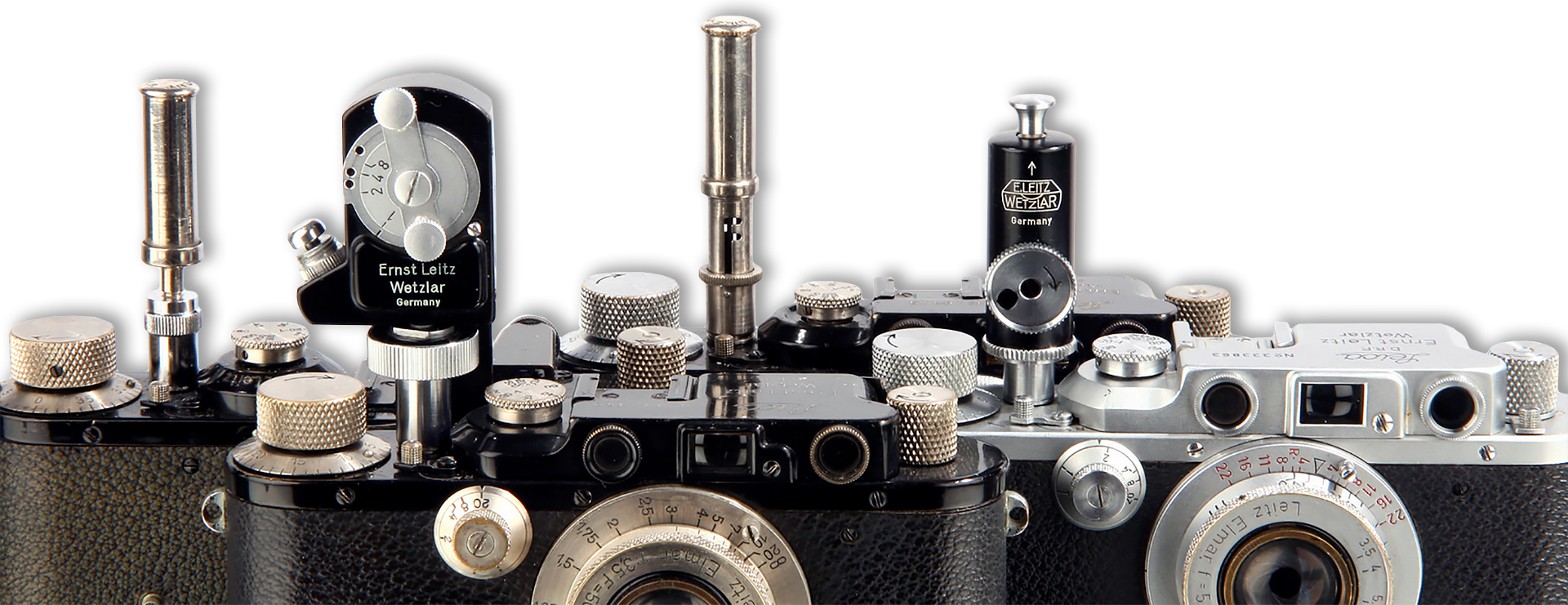
Most of the self-timers of this survey come from the sites of autoknips.jimdofree.com, flynngraphics.ca and earlyphotography.co.uk
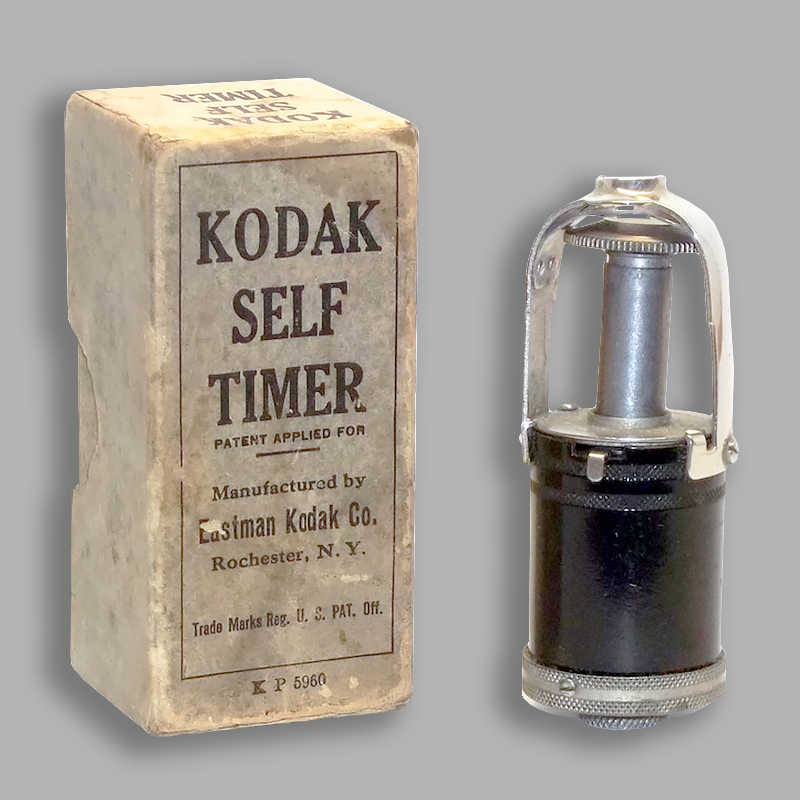
Kodak pneumatic Self-Timer
This Kodak Self Timer has been found in a Kodak catalogue from 1918, so this is the date allocated. The timer is used with a cable release clipped into the top.
The device is restrained by a partial vacuum, after triggering the timer a robust spring sets off. Towards the end of the piston travel a hole is uncovered, this allows the chamber to rapidly fill with air releasing the quite strong spring and firing the shutter.
The time-set delay is variable between 0,5s – 3 minutes, set by wheel on base. Patented Feb 12 1918.
- Origin: Kodak, USA
- Year: 1918
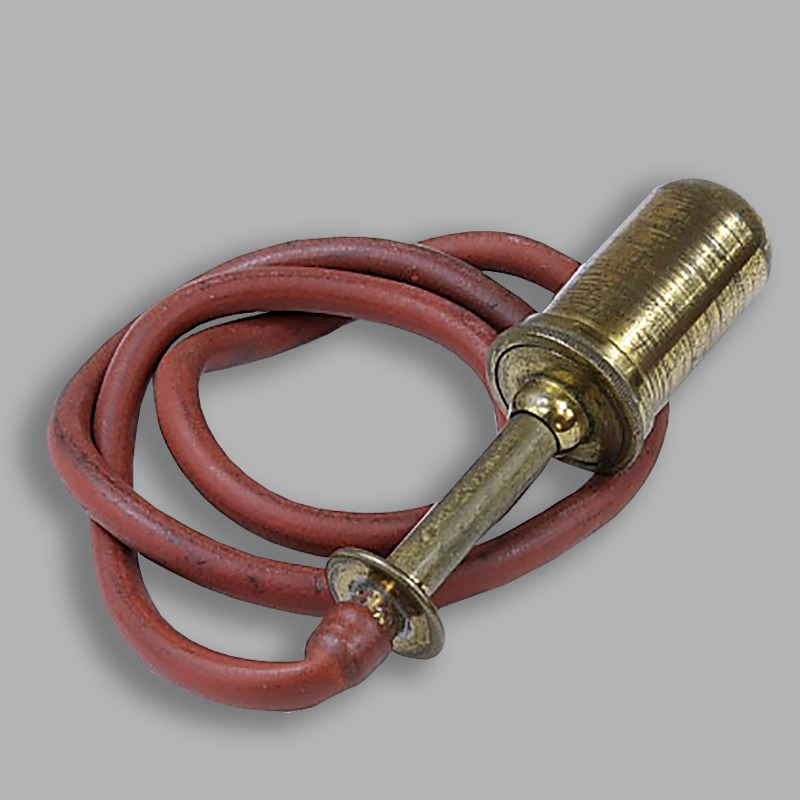
Lancaster Patent Pump
This Patent Pump was used in place of the conventional rubber bulb. The cylinder is returned by spring action. It was supplied with some Lancaster shutters and was also available separately. Although marked ‘PATENT’ the patent has not been located.
J. Lancaster & Son was a photographic company, based in Irving Street, Birmingham, England. James Lancaster started an optical firm for the manufacture of glasses, microscopes, and telescopes there in 1835. Lancaster made its own lenses and had patents for shutters. Other products were magic lanterns and photographic enlargers.
- Origin: Birmingham, England
- Year: 1895
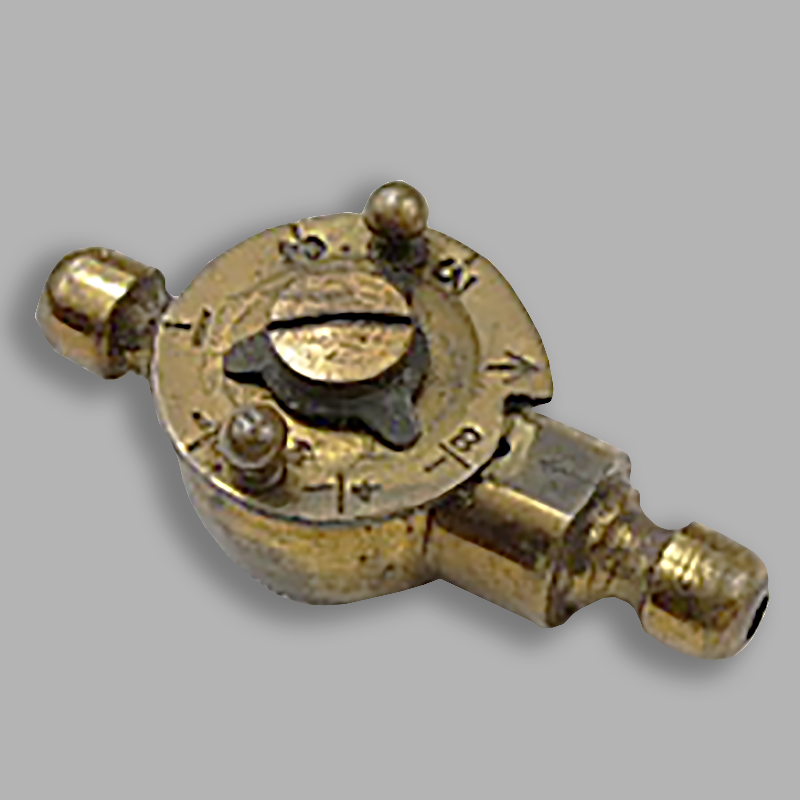
Time Exposure Valve
Slow speed timer manufactured by Thornton-Pickard Manufacturing Co. Ltd in 1899. Thornton-Pickard was a British camera manufacturer based in Altrincham, near Manchester, which operated from 1888 to 1939.
Air-valve type to fit within the tube of a bulb* release. With finger grips to adjust the speed. Speeds 1/8 – 3s.
* “Bulb” refers to the rubber shutter release bulb at the end of a rubber tube. Though mechanically timed exposures could also be triggered by squeezing the shutter release bulb, “Bulb” exposures then had the same momentary action as today’s cameras.
- Origin: Altrincham, England
- Year: 1899
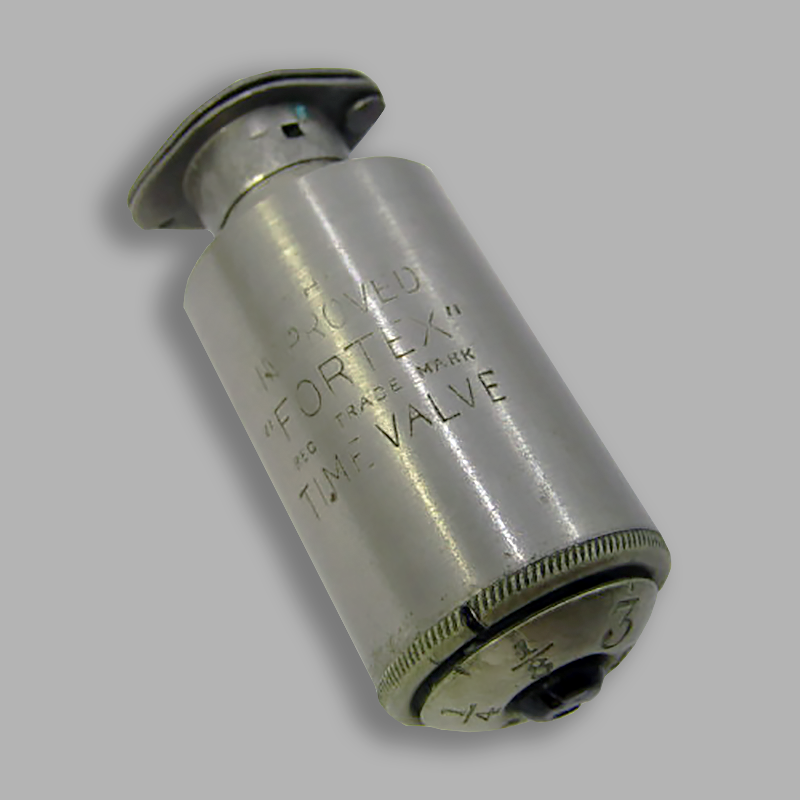
Fortex Time Valve
This is a pneumatic delayed action device, patented and made by F W Baxter, Brixton, London, in 1912. The device was marketed by Griffins’, Kingsway, London. The “House of Griffin” was pioneer photographic supply house, in addition to a significant book publisher.
The Fortex Time Valve had a pneumatic delay between ⅛ – 3s. It fitted a cable release and was provided with a reducing washer to fit cable release. The end of the piston is fixed to the cable release and drawn out. To make the exposure the piston and cylinder are pushed together by hand.
- Origin: London, England
- Year: 1912
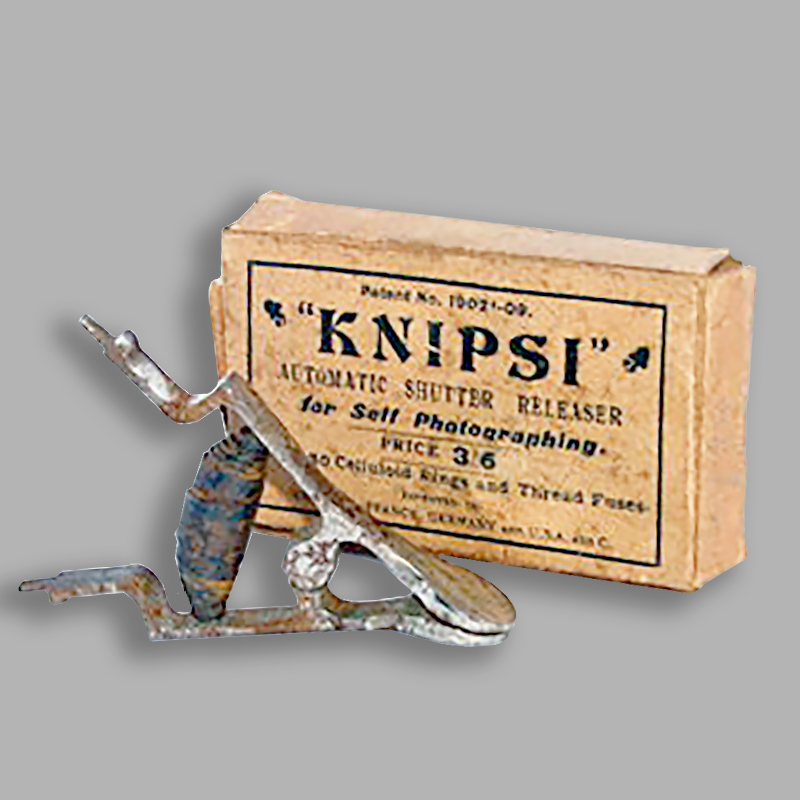
Knipsi
This little snapper of Carl Baser has a strong bite. Well over 100 years old, it still destroys every shutter release bulb today. It is only stopped by a small celluloid ring that encloses the two outer ends of the pincer-like construction. This threatens to come to an abrupt end, since a small fire on a fuse moves steadily towards it. When the ring ignites, the force of the strong spiral spring is released and the trigger bulb is pressed together so that a pneumatic lock is triggered. Meanwhile, the blazing celluloid ring disappears into the carpet or curtain – and provides further activities of a completely different kind.
- Origin: ???, Germany
- Year: 1907
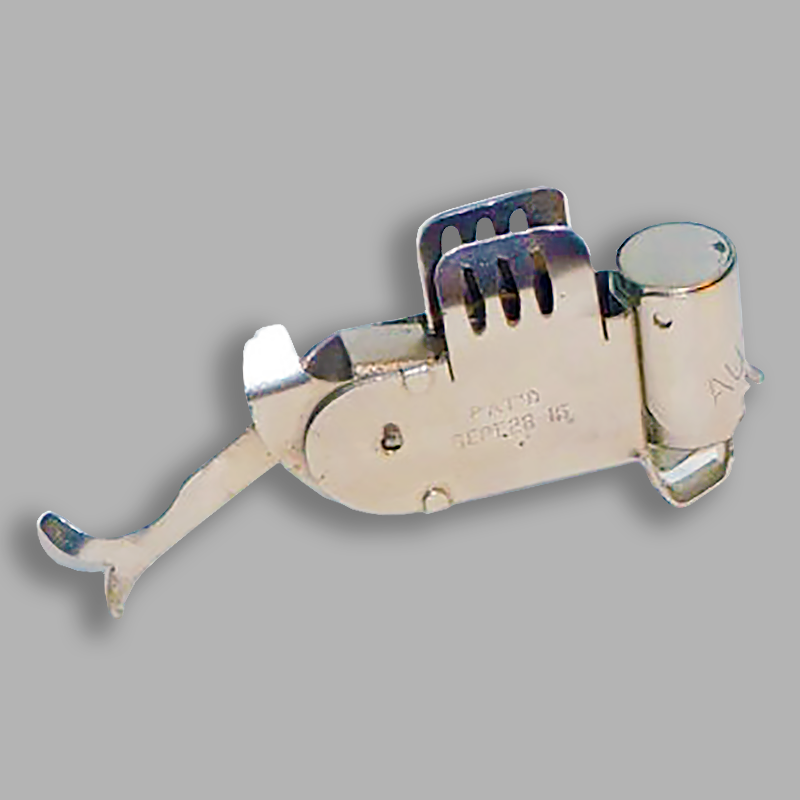
Autosnap shutter operating device
The technology of the Autosnap is extremely unusual: it works with water! For this purpose it has a cylindrical container filled with cotton, which is first soaked in water. The Autosnap is now stretched and held with a piece of blotting paper, which slowly loses its stability due to the rising moisture of the cotton. After 15 to 20 seconds, the paper tears and releases the spring to compress the cable release.
The developer of the Autosnap was Benjamin A. Slocum. He first developed a fuse-operated self-timer. His second self-timer should now directly move a cable release free of ignition sources.
- Origin: Rochester, USA
- Year: 1916
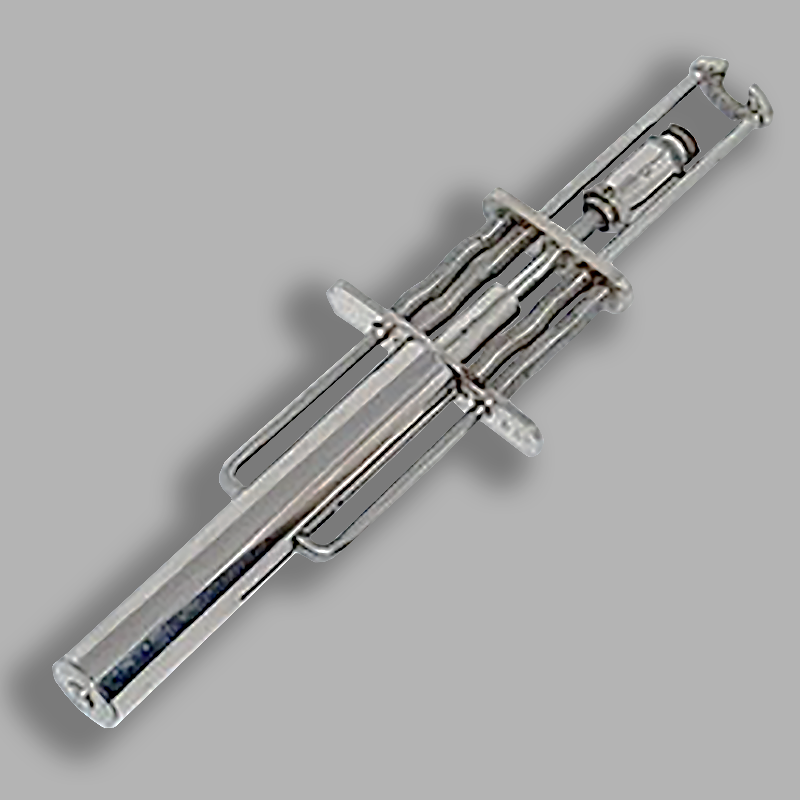
Photoperfect
The Photoperfect is based on the principle of an egg timer, in which fine-grained sand flows from the upper chamber to the lower one, thereby causing a shock-free compression of a cable release. By swiveling the sand container around a central axis of rotation, the Photoperfect could be made ready for operation again.
The developer of this unusual technology was the Berlin student Carl Weber, who was to design many self-timers. When he was just 21 years old, he founded Photoperfect GmbH for the ‘manufacture and distribution of photographic automatic release devices’ in Berlin-Wilmersdorf. Just a few months after the company was founded, there was even a second model adjustable self-timer, with a size of 67 mm and a weight of 31 g.
- Origin: Berlin, Germany
- Year: 1912

Direkt
The Direkt of Dr. Carl Weber set a milestone in the development of self-timers. The patented design was immediately convincing in terms of handling, reliability and price. While his Photoperfect required a relatively large size due to the volume of sand, Weber was able by switching to oil hydraulics to develop a very compact self-timer, which, due to its low weight of 10 g, could now be attached directly to a camera shutter. Accordingly, the self-timer, initially known as Photodirect, was given its final name: Direkt.
However, Carl Weber continued to develop a new model and thus further pushed forward the miniaturization of the perfect self-timer. The Direkt for smooth-working shutters became a total length of 33 mm and a weight of an incredible 6.5 grams.
- Origin: Kiel, Germany
- Year: 1929 – 1931
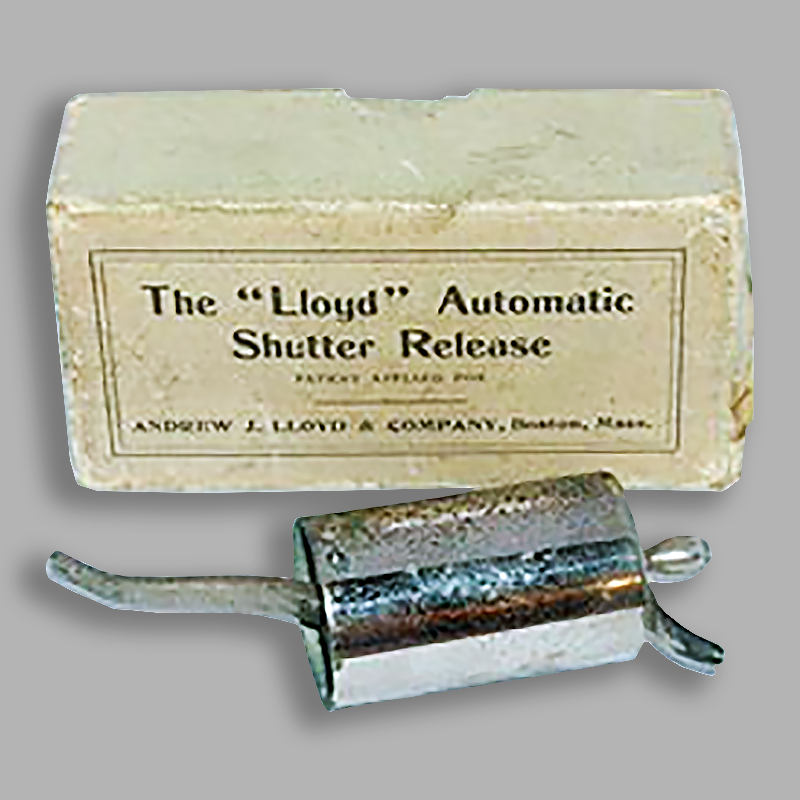
The Lloyd Automatic Shutter Release
This little timer is from Andrew J. Lloyd of Boston. The cylinder, which is only 45 mm high and has a very strong spring, can easily hang from a lock and be triggered using a fuse. Priced at $1.00, it should be an inexpensive alternative to expensive hose extensions. The packaging included 20 fuses and detailed instructions for use.
The company Andrew J. Lloyd & Co. was founded in 1870 and by the turn of the century its catalog ‘Photographic Encyclopedia’ had a whopping 400 pages full of cameras and photographic accessories.
The self-timer was developed by Benjamin A. Slocum (1873-1965), a student at the American School (Chicago, IL), Armor Institute of Technology.
- Origin: Boston, USA
- Year: 1901
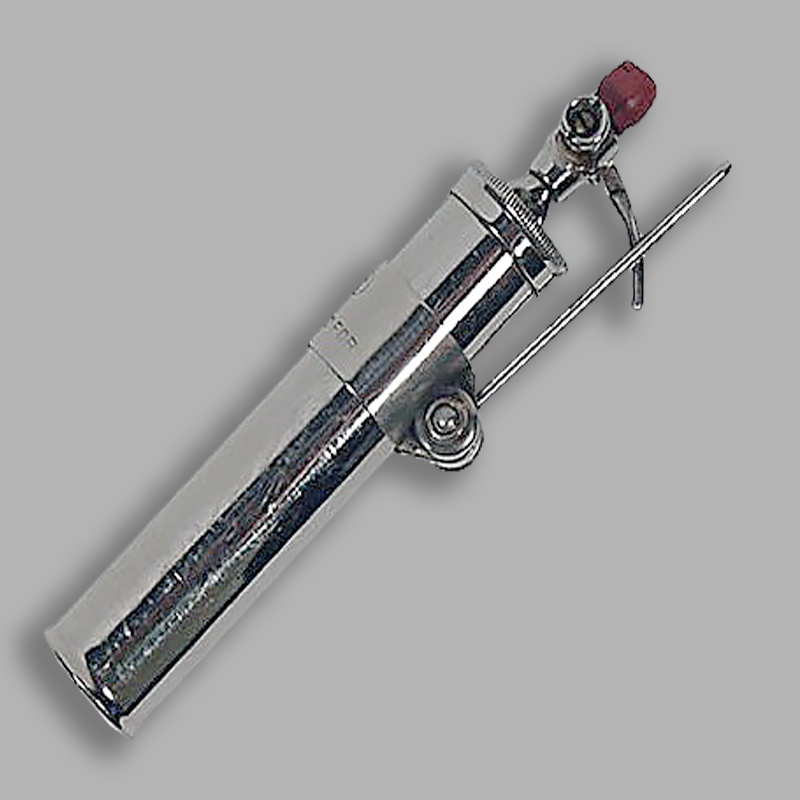
Autopoze Camera Self-timer
In 1900 Faries Manufacturing Company introduced a simple and compact pneumatic self-timer called Autopoze. With it you could set the lead time as well as the exposure times. The Faries Shutter Tripper was possibly the first, or second self-timing device marketed in the United States. This accessory was patented January 14, 1902. At that time, cameras didn’t had built-in self-timers.
An air hose was used to connect the self-timer to a camera’s shutter release. Attach the other end of the hose to the shutter cylinder. Pull up on the self-timer’s plunger, and release. Run around the camera and get into the picture. Air will slowly leak from the self-timer’s cylinder. At a certain point, a valve is tripped, releasing all the air at once. This sudden stream of air is what causes the shutter to fire.
- Origin: Decatur, Ill., USA
- Year: 1900
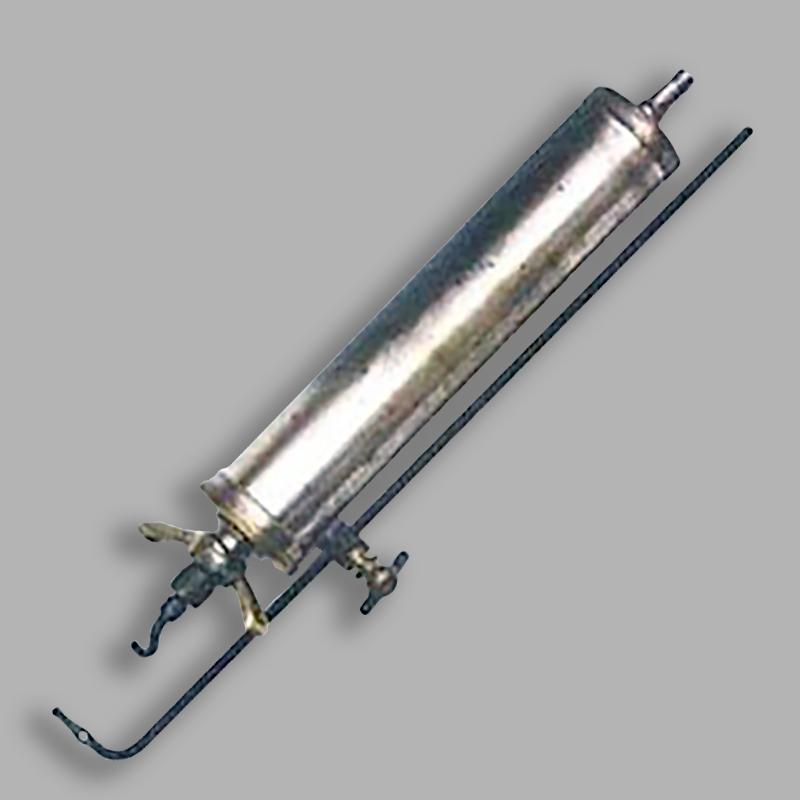
Michelin Auto Déclencheur
This type of air pump comes from the first creative phase of André and Edouard Michelin. They founded Societé Michelin & Cie., the beginning of the industrial era of pneumatic tires. The function of this self-timer is that of an air pump for pneumatic camera shutters.
For tensioning, the spring-loaded stamp is pulled out of the cylinder and fixed to the hook with a celluloid ring on the gallows. A fuse is then threaded through the small hole at the bottom of the gallows and pulled through the celluloid ring. After the fuse and celluloid ring have burned, the piston generates the air pressure required for triggering.
The displacement and thus the exposure time can be varied using the adjustable boom on the side.
- Origin: Clermont-Ferrand, France
- Year: 1898
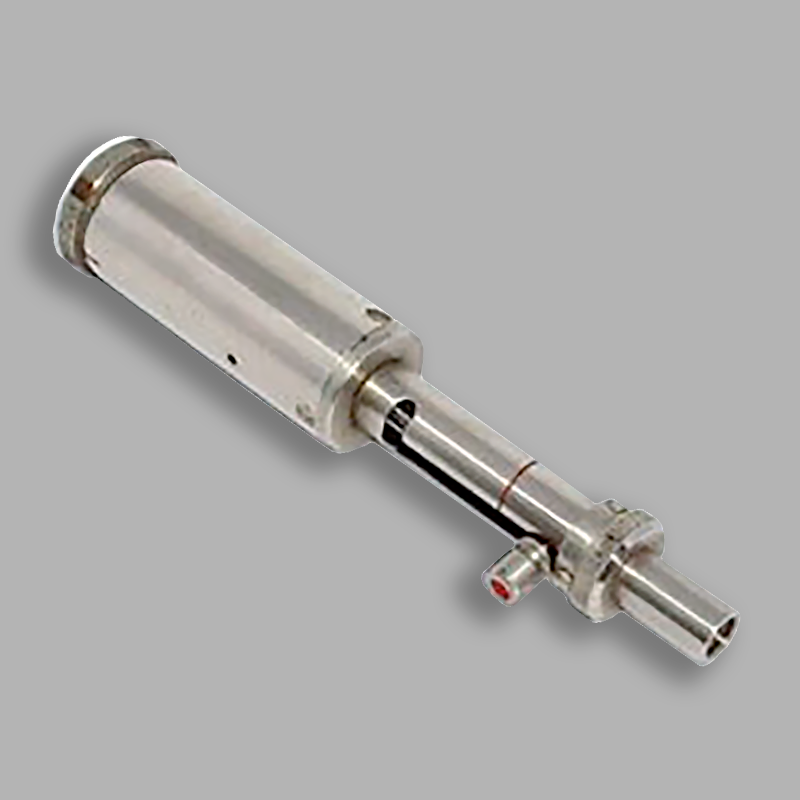
Retardeur pour Monobloc
The Monobloc camera was manufactured by Jeanneret & Cie in circa 1920 and has a built-in magazine for glass plates. It was made in two models. A stereo camera for 6 x 13cm plates and a Stereo and panoramic combination camera.
The camera was constructed of metal and finished in black enamel paint, polished metal and leather covering. .
The Monobloc also has a special thread onto which a specially offered self-timer can be screwed. The self-timer is 11 cm long and has a pneumatic escapement. To tighten it, the small lever is pulled-up and locked there with a small twist like a bayonet connection. By turning the head wheel now, different expiration times can be selected by changing the air supply.
- Origin: Paris, France
- Year: 1922
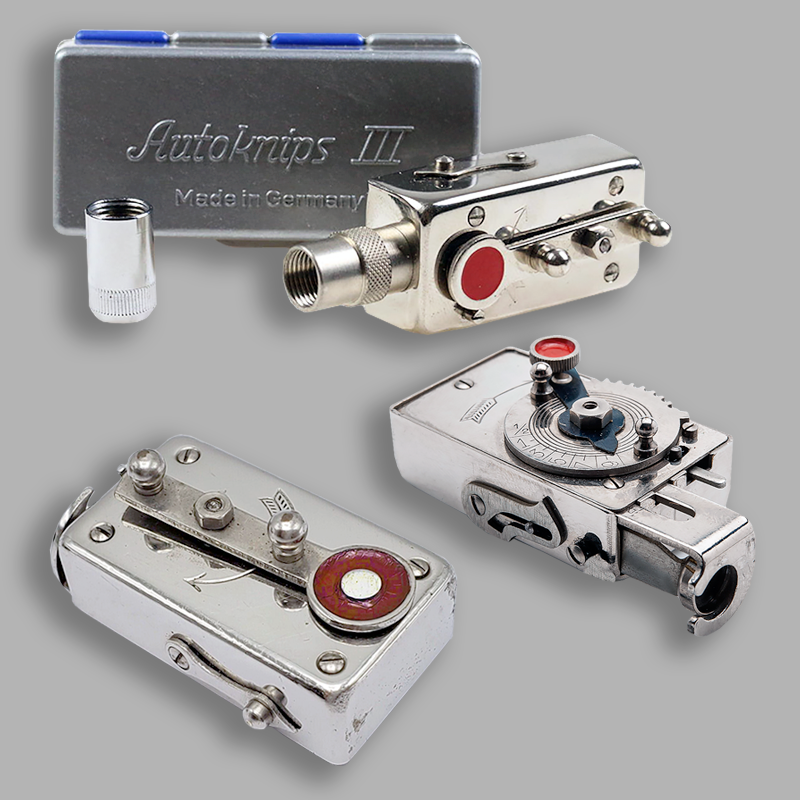
Autoknips Pre-War Models
The Autoknips has been manufactured for over 60 years. Over this time it changed its appearance often, especially in its size. A total of three different types can be described before WWII:
Type 1: Original type, DRGM, large case (45 x 32.5 mm) (1923)
Type 2: original, DRGM, smaller case (41 x 23.5 mm) (1923-1928)
Type 3: further reduced housing (39.5 x 22 mm) (1928-1931)
The Autoknips III was registered as DRGM in the summer of 1936 and was manufactured almost unchanged until 1973. Only the side locking lever and some variations in the labeling reveal a more precise manufacturing period.
The price of this item was: 6,50RM in 1936; 12,-DM in 1950-1954; 12,- up to 15,60DM in 1954-1973.
- Origin: Hamburg, Germany
- Year: 1936
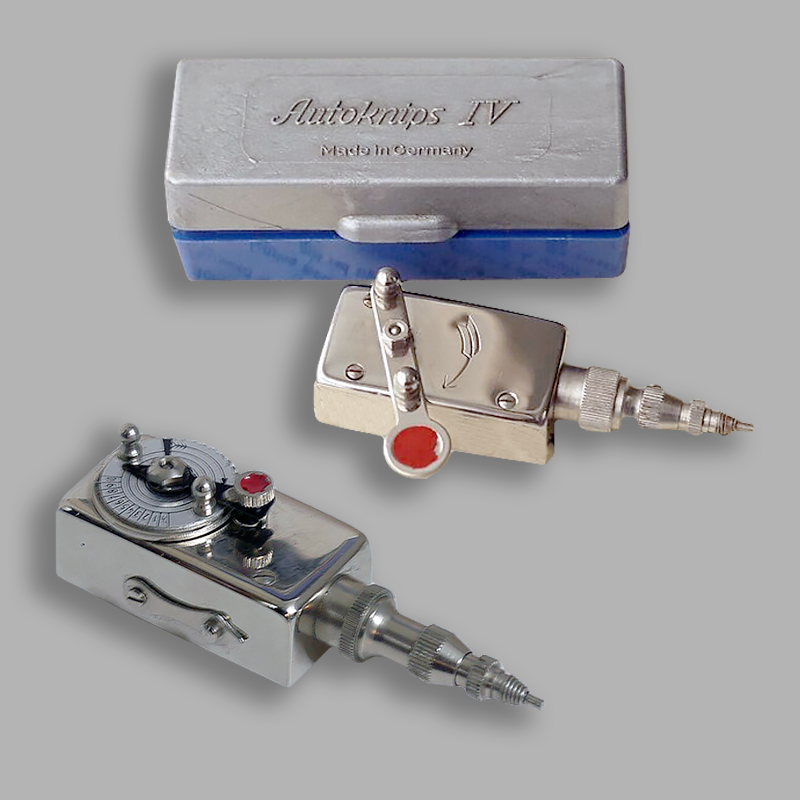
Autoknips post-war models
After the Second World War, Friedo Klapprott re-started producing self-timers. Together with his brother-in-law Georg Lampe, the ‘Klapprott & Lamp Autoknipsfabrik’ was founded in Hamburg-Rahlstedt in 1950.
In the course of the rebuild, some details of the Autoknips models 1, 2 and 3 were changed. After production of these three Autoknips models had re-started, Klapprott & Lampe made the Autoknips IV, a self-timer that can be screwed directly onto the shutter.
The reason for another Autoknips model was the logical consequence of combining the most attractive elements of previous models. The Autoknips V therefore became a timer that can be screwed directly onto the camera.
- Origin: Hamburg-Rahlstedt, Germany
- Year: 1950
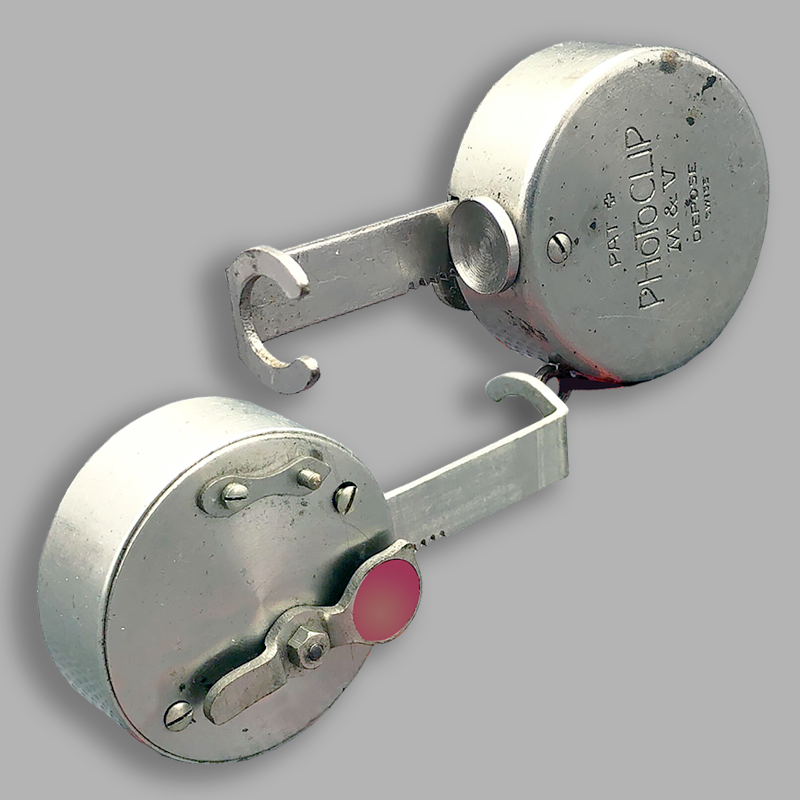
Photoclip (first model)
The Photoclip is the best-known representative of the Swiss self-timer. Its round shape isinherent to the precision and reliability of a Swiss watch. In addition to the widely used photoclip A momentary release and the photoclip B timer release, there are also some directly screw-on models as well as variations for export to the USA. The first models of the Photoclip have already celebrated their 100th birthday.
In the spring of 1917, Recta brought its “automatic remote release Photoclip” onto the market in addition to the M&V precision photometer, which had already been successfully sold. The Swiss patent had already been granted in 1917. The new accessory was Swiss precision movement “in the shape of a small pocket watch” with a diameter of 41mm.
- Origin: Biel, Switzerland
- Year: 1917
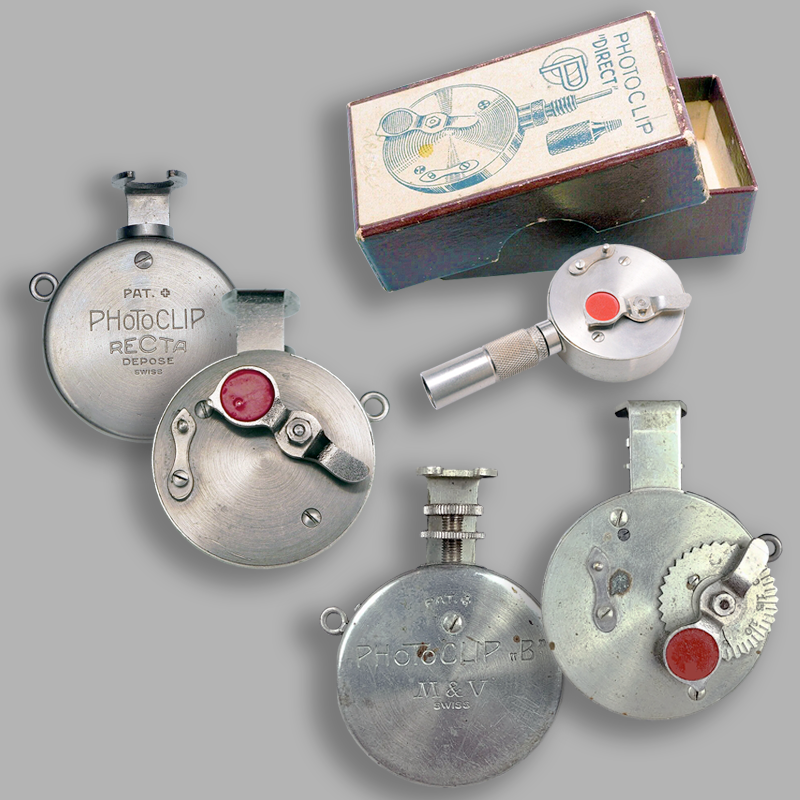
Photoclip A, B & Direct
For the first time, the Photoclip A (diameter 32 mm) and the Photoclip B (diameter 37 mm) had a housing made of solid nickel silver, an alloy made from the metals copper, nickel and zinc. This is harder and more corrosion-resistant than previous and usual nickel-plated brass. The new timer, also patented in Germany, was adjustable in stages up to 20 seconds, easy to use and very reliable.
In the 1930s, the desire arose to screw a self-timer directly onto a camera shutter without inserting an additional cable release in between. Recta found a very practical solution with their new Photoclip Direct, whereby almost every type of exclusion was considered: a Normal model for common Compur threads, a Rollei model for two-lens reflex cameras and the Leica model.
- Origin: Biel, Switzerland
- Year: 1922 – 1936
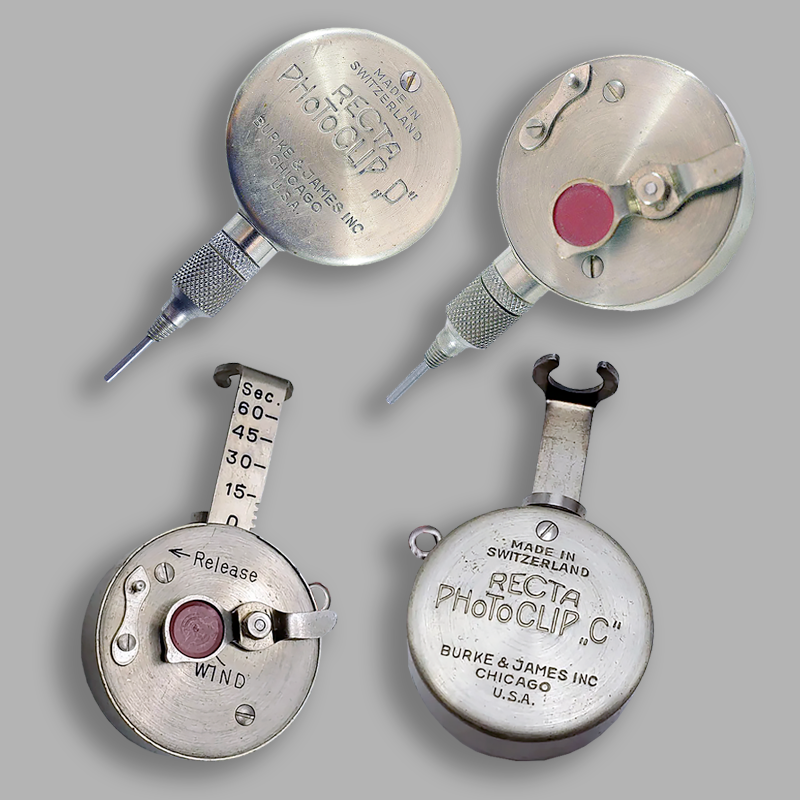
Photoclip D & E (USA Market)
In its search for new sales markets, Recta found a suitable partner in Chicago. Recta produced a Photoclip Model C exclusively for Burke & James as a special accessory for Polaroid.
The highlight of this device was the engraved numbers on the gripper rail, which moved as it ran. The self-timer could also be used as a timer of 60 seconds for the development time of images from the new Polaroid Land ‘Picture-in-a-minute’ camera.
Another model from Burke & James was the Photoclip D. Apart from the labeling on the back, it did not differ from the original Photoclip Direkt and, like the latter, was suitable for screwing directly onto the camera. The Photoclip D was also offered in three versions: Normal, Rollei and Leica models.
- Origin: Biel, Switzerland
- Year: 1949 – 1950
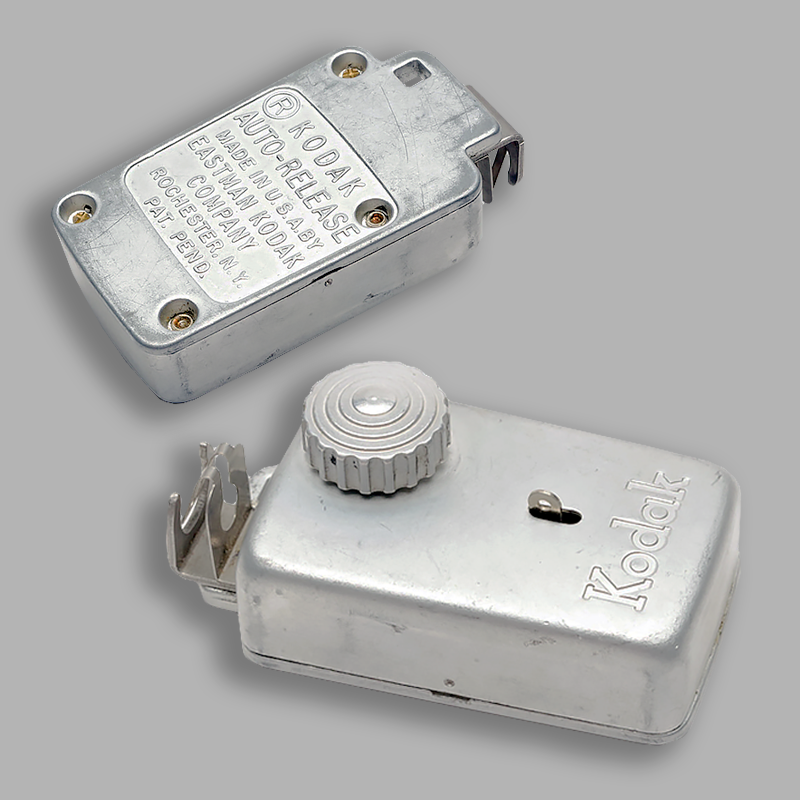
Kodak Auto-Release Self-Timer
After successfully selling the in february 1918 patented, classic among US self-timers, the hydraulic Kodak Self Timer for over 30 years, Eastman Kodak introduced this new mechanical self-timer: the patented Kodak Auto-Release.
Turning the knob creates space for placing the head of the release cable. Its light aluminum housing contains a clockwork that initially runs slowly for the lead time, but then runs powerfully and quickly shortly before it is triggered. The clock work mechanism fires the shutter after about 10 seconds.
Furthermore, the cable release can be clamped directly to the gripper arm so that nothing wobbles. And finally, the loud running noise guarantees attention towards the camera.
- Origin: Richmond, USA
- Year: 1950
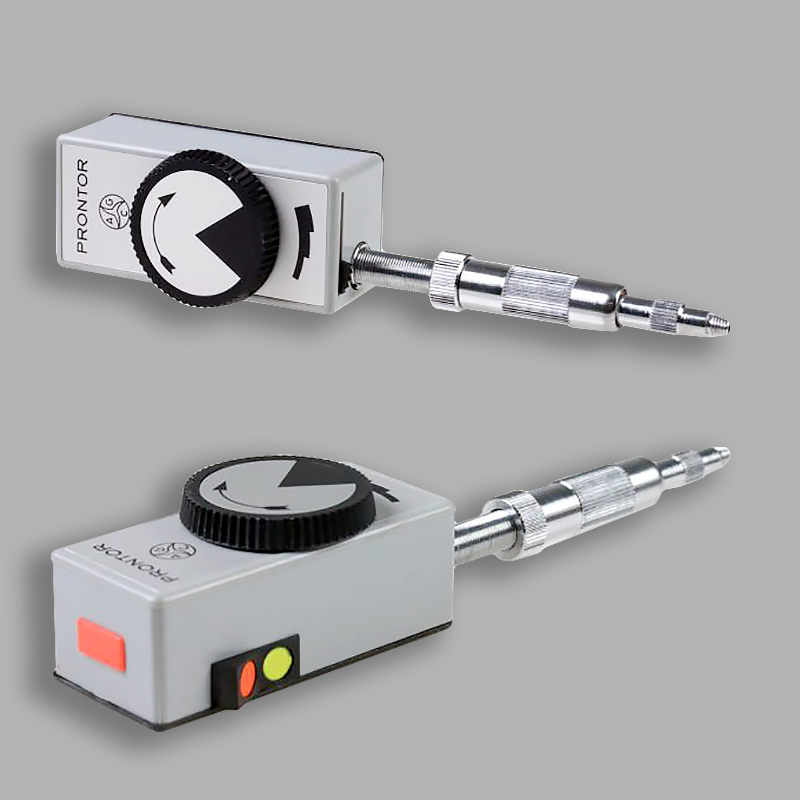
Prontor self-timer
At times when just more expensive cameras had a built-in self-timer, a separate self-timer was needed for fewer more expensive cameras on which the photographer wanted to be in the picture. The well-known shutter manufacturer Prontor-Werk Alfred Gauthier GmbH, Calmbach, Germany also launched such a self-timer.
The Prontor is an absolutely perfectly equipped device in an almost huge housing. The design does not look like others from that time. This device offers 3 different lead times of 7, 14 and 20 sec, triggered by a traffic light switch on the left side.
The different lead times are adjusted by an election lever on the underside. The end of the lead time is shown on the top by an orange pointer.
- Origin: Calmbach, Germany
- Year: 1957
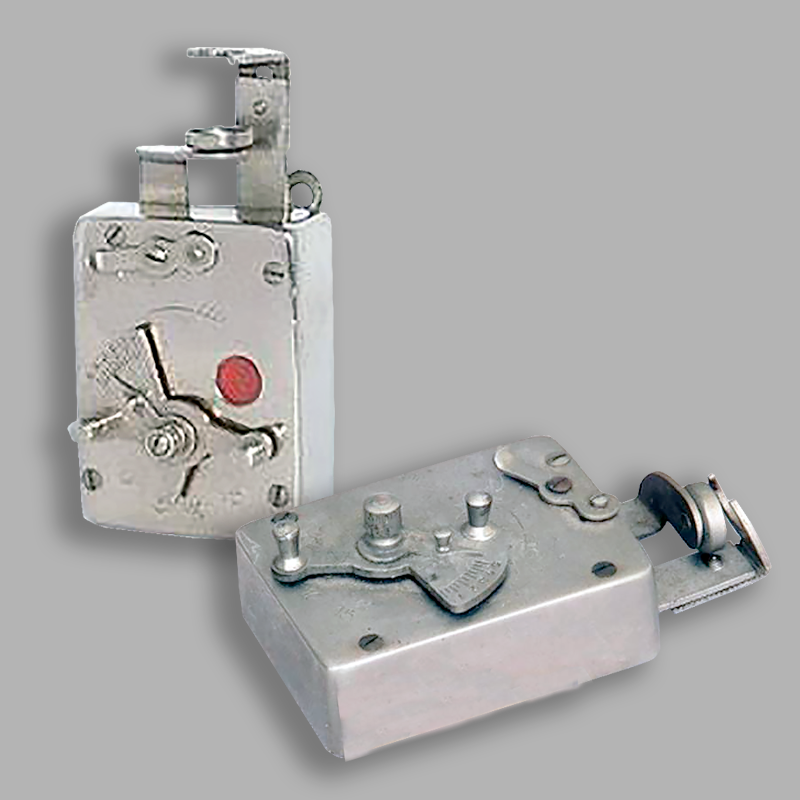
DBK (Chronos) Self-Timer
Albert Drexler from Kochel am See and Michael Burger from neighbouring Benediktbeuern developed their first self-timer in 1921.
The red signalling point was new. It was only visible in the tense state of the self-timer and was covered by the elevator lever before triggering.
The name Chronos, which the Ernemann company had already protected as a trademark for its camera shutter of the same name, was not new. So, since August 1921, this self -timer has simply been called DBK Self-Timer.
Sales took place in the first few months via Führer & Cap and thus also through their sales channels to Switzerland, Denmark and Scandinavia, Holland, Czechoslovakia and Italy.
- Origin: Kochel am See, Germany
- Year: 1921
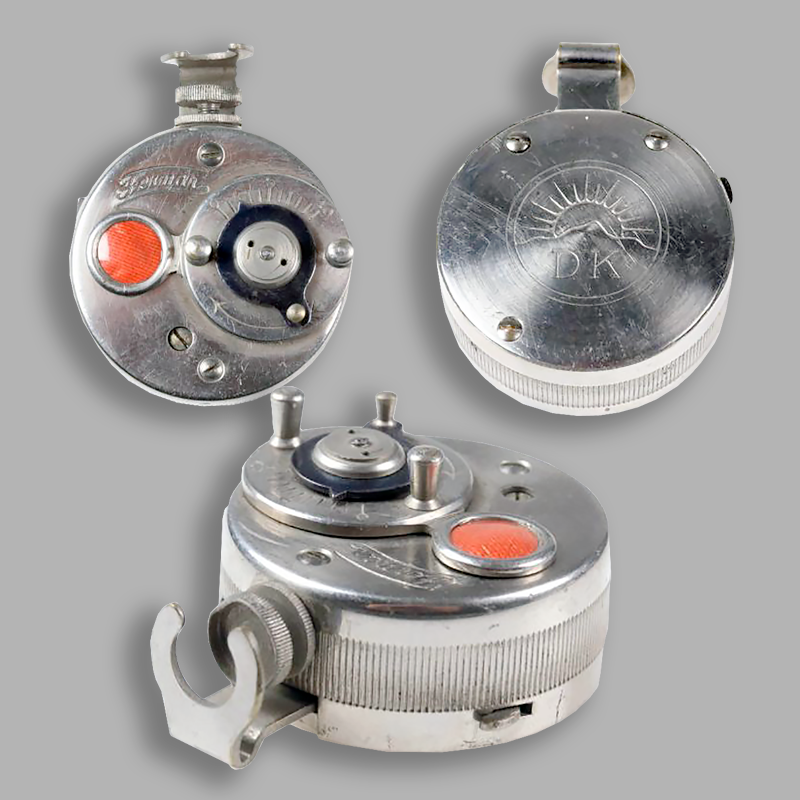
DK Fernar Self-timer (A up to E)
When Michael Burger left the company, the company name ‘DBK’ was initially reduced to ‘DEKA’, then to ‘DK’. Drexler’s new partner was Franz Bauer from Munich, who also took over general sales. Drexler presented his self-timer in May 1923 at the First International Fair for Photography and Cinematography in Turin and made new contacts.
First, Drexler and Bauer worked together to develop a new self-timer called Fernar. The idea arose from the Photoclip B, which had been on the market since 1922 and which, for the first time, compressed the clamped cable release slowly – and thus gently – on the cable release.
In order not to violate existing patent law, the self-timer release rail did not tension automatically.
- Origin: Kochel am See, Germany
- Year: 1924 – 1929
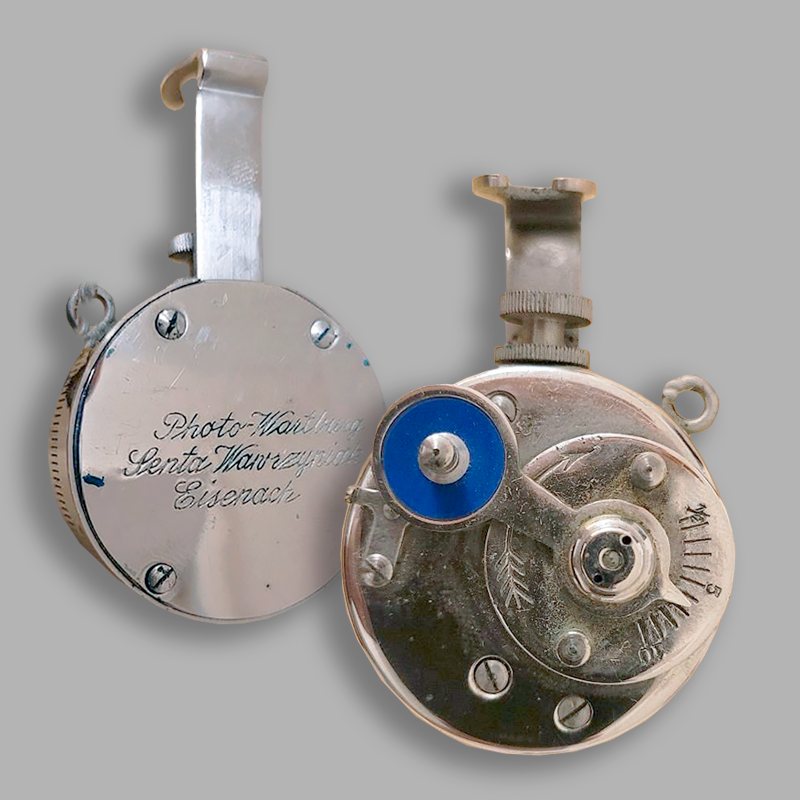
DK Favorit Self-Timer
DK offered this new self-timer as the Favorit. The immediately noticeable difference is the blue color of the signal disk. More important was, that buyers of larger quantities could now have their own name added to the label Favorit (e.g. Adina, AS, Errtee, Frama, Reporter) as well as the sometimes long names of individual camera shops (e.g. Photohaus Max Klinke Berlin, etc., etc.).
When box cameras became increasingly popular as simple, inexpensive snapshot cameras in the 30s, the demand for an equivalent self-timer grew. Drexler responded in 1933 with a simple release without signal disk, which was available for less than 2 RM in a black painted version. A nickel-plated version was just a little more expensive. Here too, bulk buyers were able to have their own names added.
- Origin: Kochel am See, Germany
- Year: 1929 – 1938
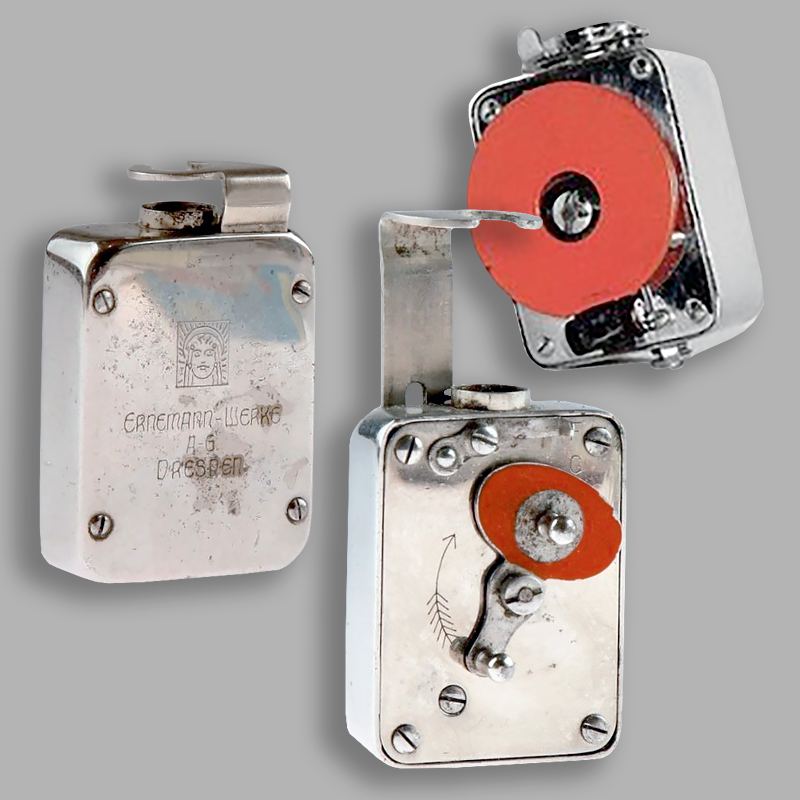
Autex 1 & 2 (First version)
Ernemann has always been at the forefront when it comes to developing self-timers. The best-known model from Ernemann was the Autex, which was available in very different designs and functions. With the Autex, Ernemann developed for the first time a clockwork self-timer that could directly press a cable release. A special eye-catcher was the large fold-out signal disk, with which you could observe the activation process from a distance. With its 85 grams, the Autex was offered as a “small, extremely ingeniously crafted precision clockwork of extremely small dimensions and low weight”.
Ernemann expanded the Autex: the new Autex II has an additional adjusting disk on the back for setting the desired exposure time, a total weight of 100 grams and a price of 18 RM.
- Origin: Dresden, Germany
- Year: 1935
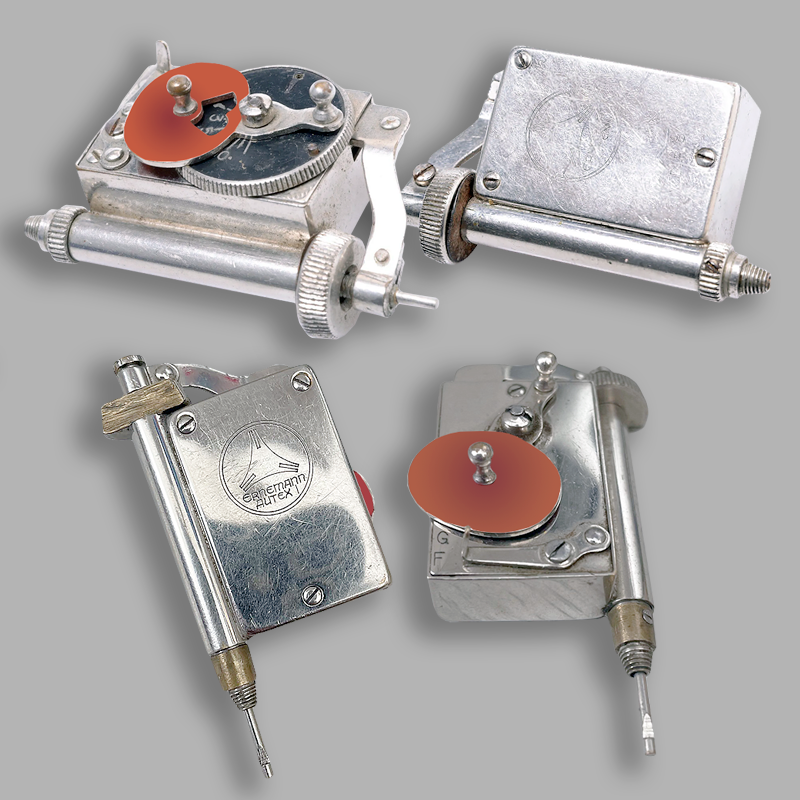
Autex I & II (Second version)
When the DRGM’s rights to the Autoknips expired in February 1918, Ernemann followed up with a slimmed version of its Autex I. The new version was only about half as thick as its predecessor at 85g and now even slightly lighter than its competitor at 58g. It also had a red painted signal disk. Just two years later, another revision took place, which led to a further weight loss from 58g to just 39g. The basic elements were retained, especially the red-painted signal disk.
With the new design of the Autex I, the timer has also been relaunched. The old model had no longer been available since 1917. The new Autex II now had a black time disc with the ability to adjust the exposure time from 0 to 10 seconds and a height-adjustable plate for the cable release.
- Origin: Dresden, Germany
- Year: 1918 – 1926
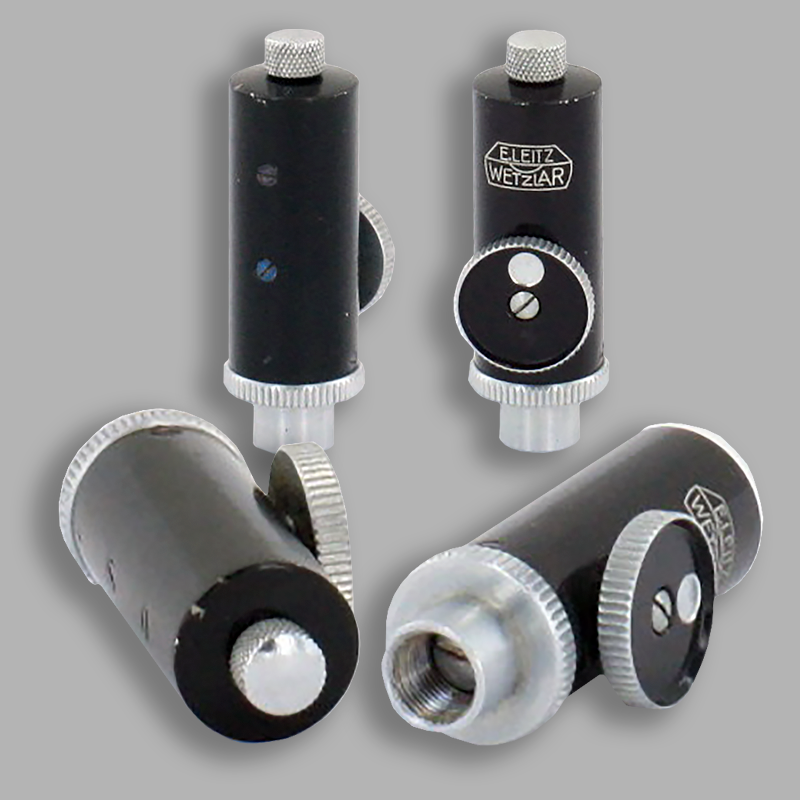
Leitz pre-war APDOO
The demand for an optimally functioning self-timer increased, and criticism of the incalculable lead time of the Leica Direkt also became louder. It was therefore decided in Wetzlar to design their own self-timer with reliable clockwork functionality and a process that could be seen from a distance. The first concept for their future APDOO took place on November 26, 1935
After more than three years of development work, Leitz brought its own self-timer onto the market. Since October 1938, this sought-after Leica accessory has been available under the code word APDOO, painted black with the typical “bell” for screwing onto the Leica. The cylindrical head and a black signal disk with a metallic signal point are typical of the pre-war version of the APDOO.
- Origin: Wetzlar, Germany
- Year: 1935
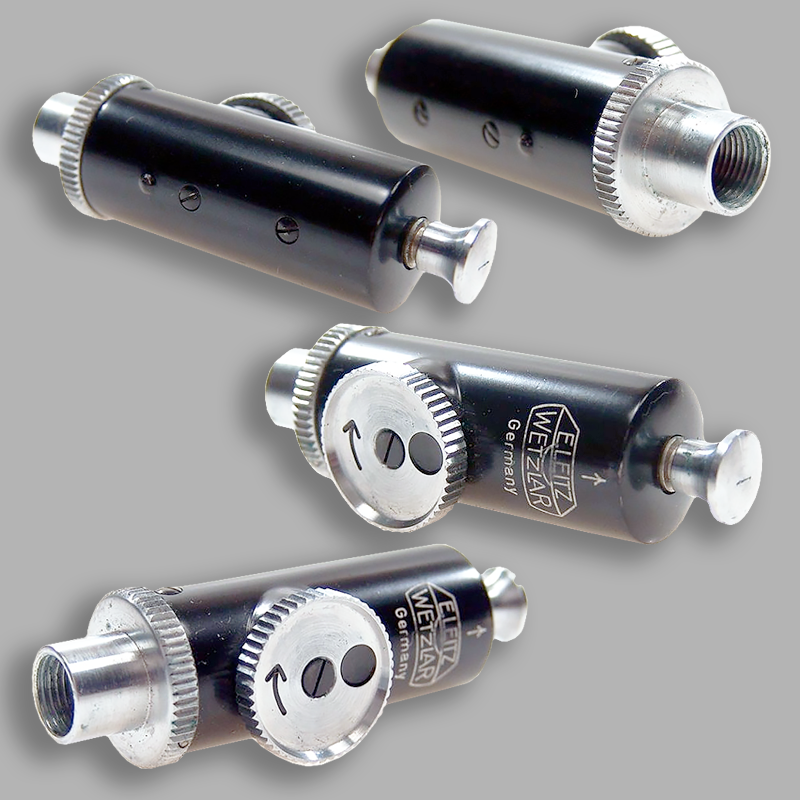
Leitz post-war APDOO
A characteristic feature of the vertically on the camera release knob mounted APDOO self-timer in its post-war version, is its mushroom-shaped head. An arrow above the company logo and an arrow on the signal disk should also make it easier to use.
The signal disc was initially painted black like its predecessors and has a white arrow, but from around 1949 it was chrome-plated and provided with a black arrow and signal dot.
The delay time of the APDOO was 10 or 15 seconds.
Meanwhile, all new Leicas in 1965 had a built-in self-timer, so the demand for an APDOO steadily dwindled. The final “off” came from Japanese self-timers, which were also offered in Germany from 1963 onwards.
- Origin: Wetzlar, Germany
- Year: 1946 – 1965
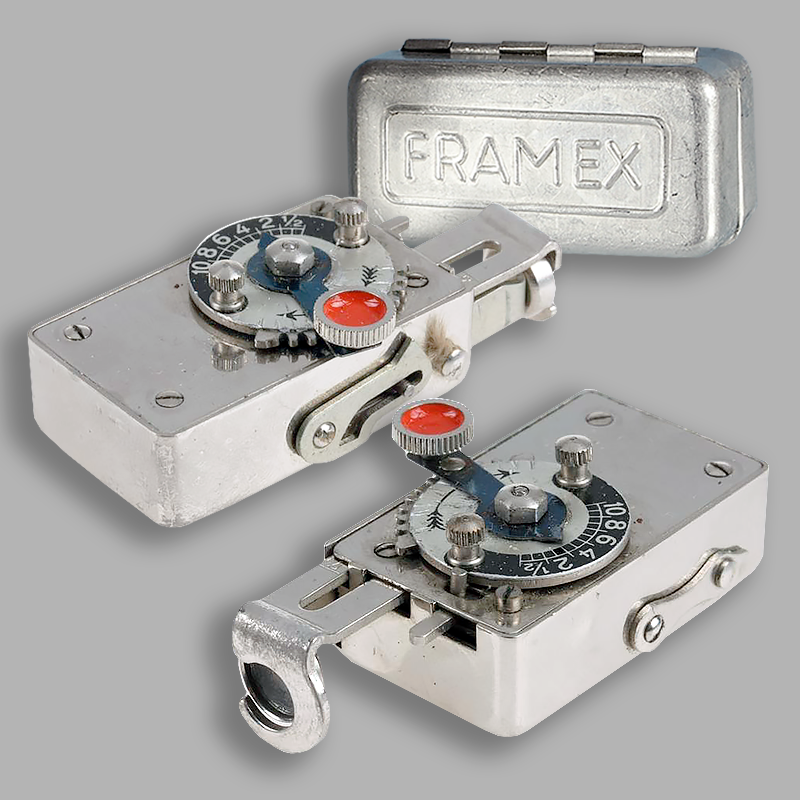
Framex Pre-War Versions
Franz Morat’s older brother Hugo took over the production of the new brand Framex self-timers in 1932. Hugo had successfully completed his mechanical engineering studies in Karlsruhe in 1928 and now founded his own precision engineering workshop in Eisenbach.
Hugo Morat developed a new self-timer based on the technology of the earlier Omega self-timer. Now, the Framex Model II had the shut-off lever on the side of the housing and a stronger clockwork. The existing Framex I speed-timer got a much smaller format too.
Simple box cameras wanted simple and cheap self-timers. Framex recognized this need and offered a simplified Framex Ia speed-timer with a thinner housing. As allways, bulk buyers could have their brand name engraved.
- Origin: Eisenbach, Germany
- Year: 1934 – 1943
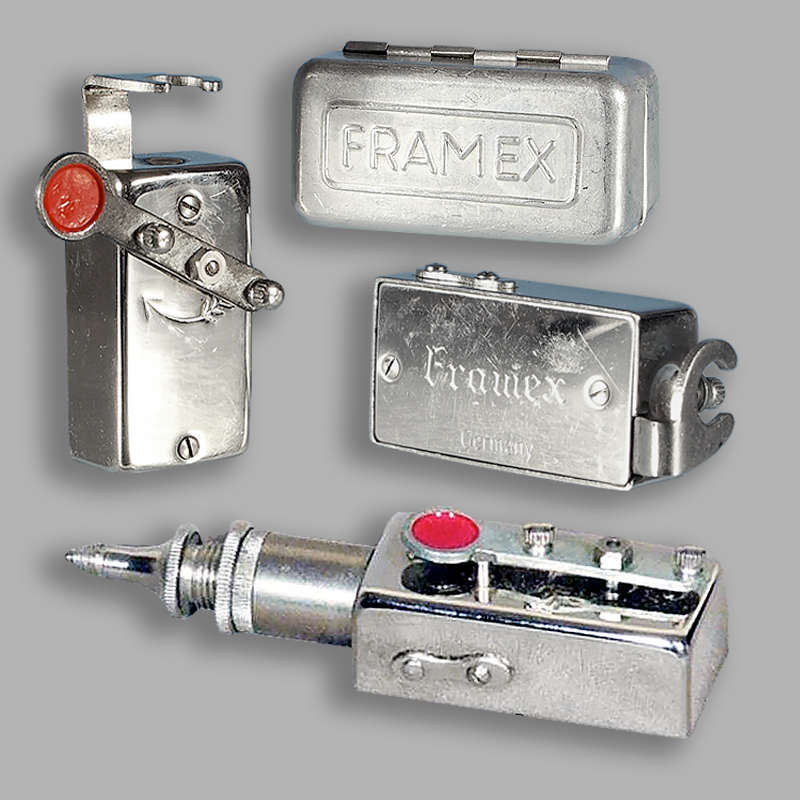
Framex Post War Versions
Hugo Morat remained loyal to the Framex self-timers and rebuilt their production after the war. A self-timer that screws directly into a Compur-shutter was already known from Japan. In Germany Klapprott & Lampe first implemented such with their Autoknips IV, Morat did this in 1954 with his Framex Direkt. Although both devices appear similar, they differ in many details. E.g. a difference is an additional lock nut, so that the signal disk always faces the observer during adjustment.
Hugo Morat died unexpectedly on March 13, 1959. With him, Eisenbach lost a brilliant technician who was completely absorbed in his engineering work. With his death, the ‘Hugo Morat Feinmechanische Werkstätte Eisenbach’ and the production of self-timers were discontinued at the end of that year.
- Origin: Eisenbach, Germany
- Year: 1948 – 1959
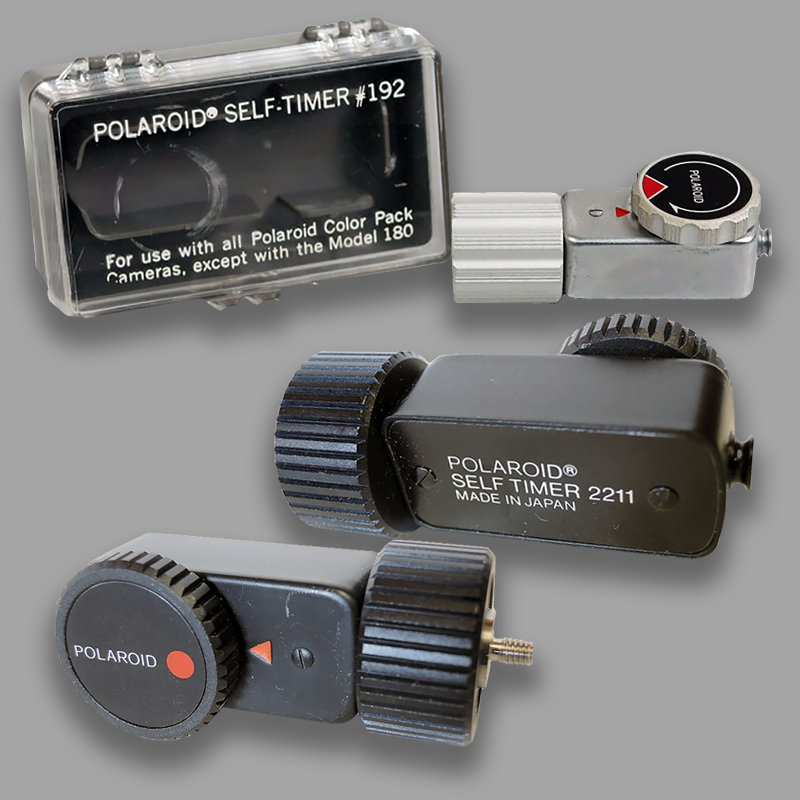
Screw-on self-timers #192 & #2211
Polaroid introduced in 1963 the Polaroid Self Timer #192 for the corresponding Polaroid Color Pack Cameras. This matt chrome-plated momentary release has a special clamping ring for attaching to the release button and was available for the Polaroid Color Pack Camera Mod. 100 to 450 (except Mod. 150, 180, 185, 190 and 195).
In 1977 the second generation of Polaroids folding cameras got a more classic self-timer with a matt black painted metal housing and a parallel thread for screwing onto the camera. The self-timer #2211 was specially designed for the EE100, ProPack and The Reporter models, but with the Polaroid Accessory Holder #2213, this #2211 self-timer fitted a lot of other Polaroid Land Cameras.
- Origin: Minnetonka, USA
- Year: 1963 – 1977
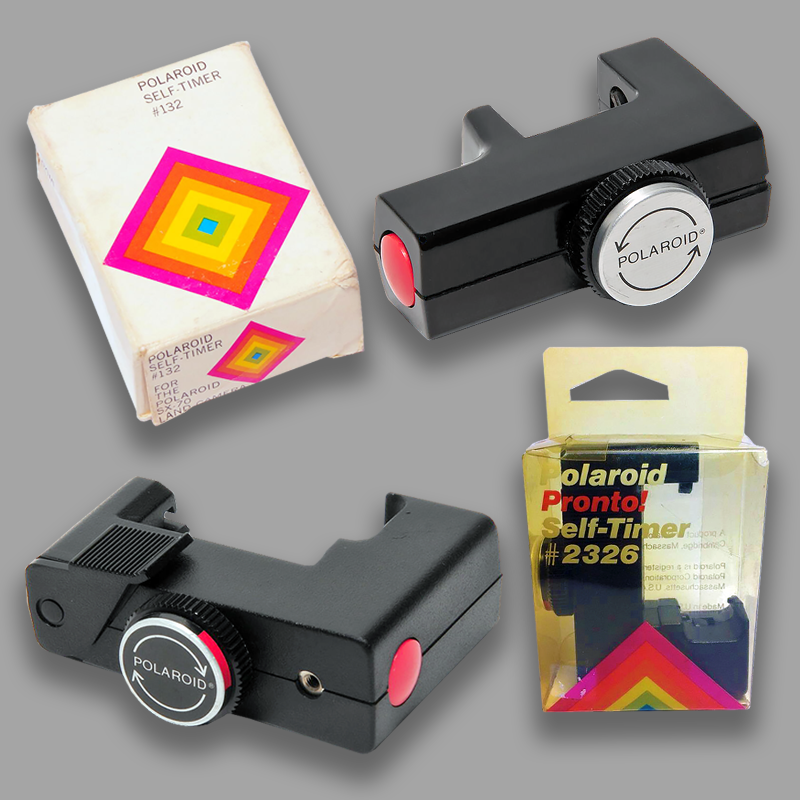
Clamping Self-Timers #132 & #2326
Polaroid launched in 1972 the SX-70, the first foldable SLR camera. The attachable mechanically-working self-timer #132, consists mostly of a black plastic housing with a winding wheel and a start button on the side. As a special accessory, it fits all variants of the SX 70 as well as the later models SLR 680 and SLR 690.
Using the SX-70’s technology and film, Polaroid developed a line of inexpensive, boxy instant cameras. The matching self-timer #2326 had a matt black plastic housing and an additional connection for a cable release and could be clipped to the camera like the #132. The self-timer #2326 fitted all Polaroid Land Cameras models 500, 1000, 1500, 2000, 3000, Encore!, Instant, One Step, Presto!, Pronto!, Revue, Super Clincher and The Button.
- Origin: Minnetonka, USA
- Year: 1974 – 1976
Finally, below are six self-timers from Canon. I have little detailed information about most of them, so I will summarize everything in one comprehensive general introduction here and limit myself to a summary of the most important information for each of the self-timers below.
Canon Self-Timers
Canon initially received self-timer supplies from Kobayashi Seiki Seisakujo Co. (KSS). In contrast to Nikon, Canon always had one or two self-timers in its sales program until 1978. The original model (“Made in occupied Japan” – 1949) was followed by models II (1951), III (1955), IV (1957), V (1957), 6 (1963), 7 (1970), 8 (1974) and E (electric for a film camera – 1975).
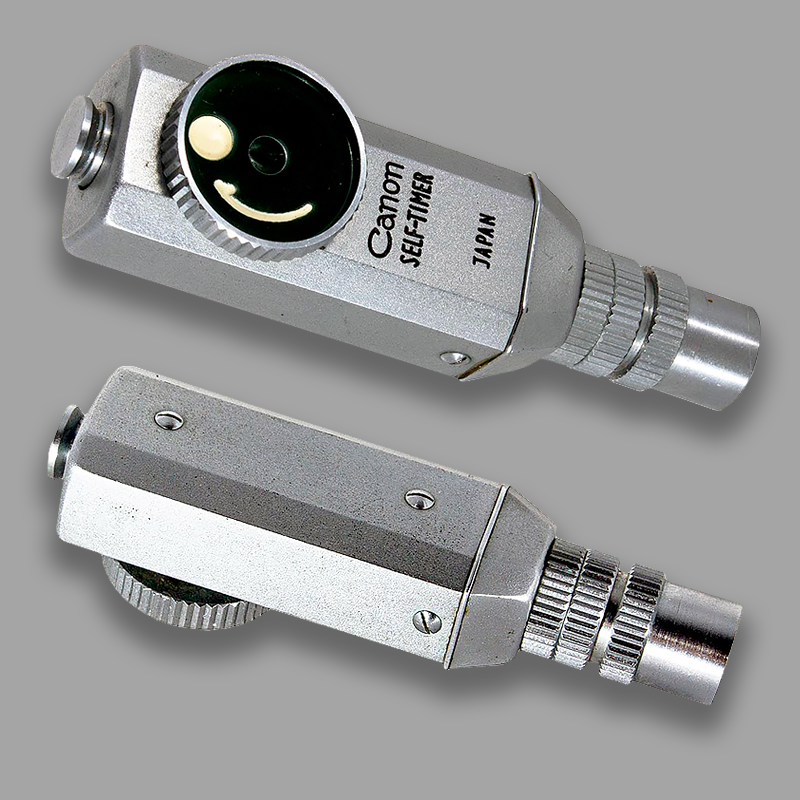
Canon Self-Timer #I
#I is a direct shutter release, matt chrome-plated with polished elevator handle, red painted signal point and height-adjustable Leica Cup for Canon I.
Until the end of 1949 with the additional inscription ‘Made in occupied Japan’.
- Year of Introduction: #I – 1949
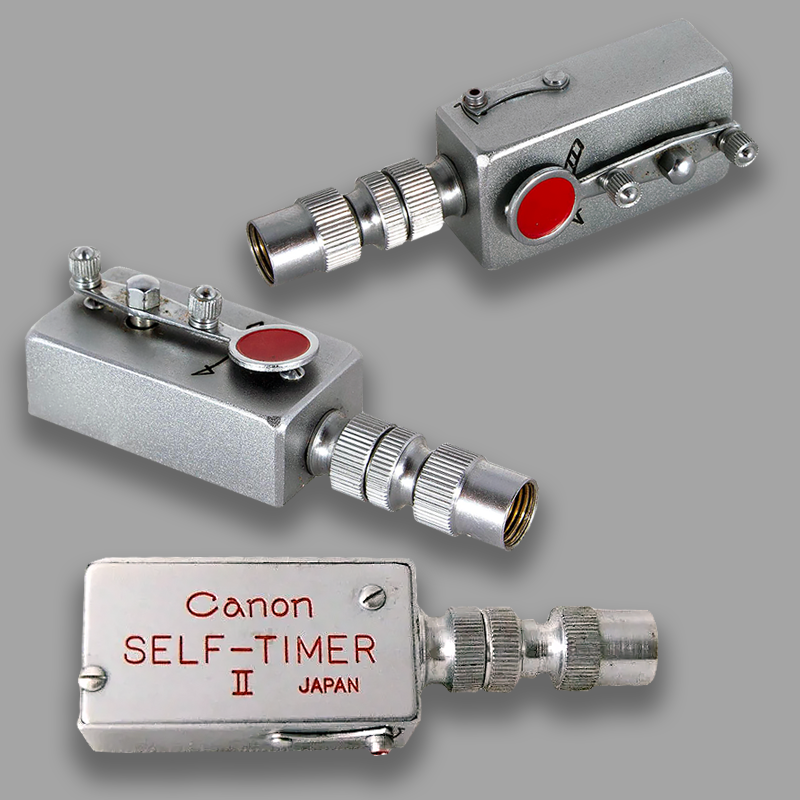
Canon Self-Timer #II and #III
#II is a direct shutter release, with Leica thread, matt chrome-plated, with red signal dot. Additional inscription on the timer either “Japan” or no inscription.
#III self-timer provided a delay of up to about 10 seconds.
- Year of Introduction: #II – 1951
- Year of Introduction: #III – 1955
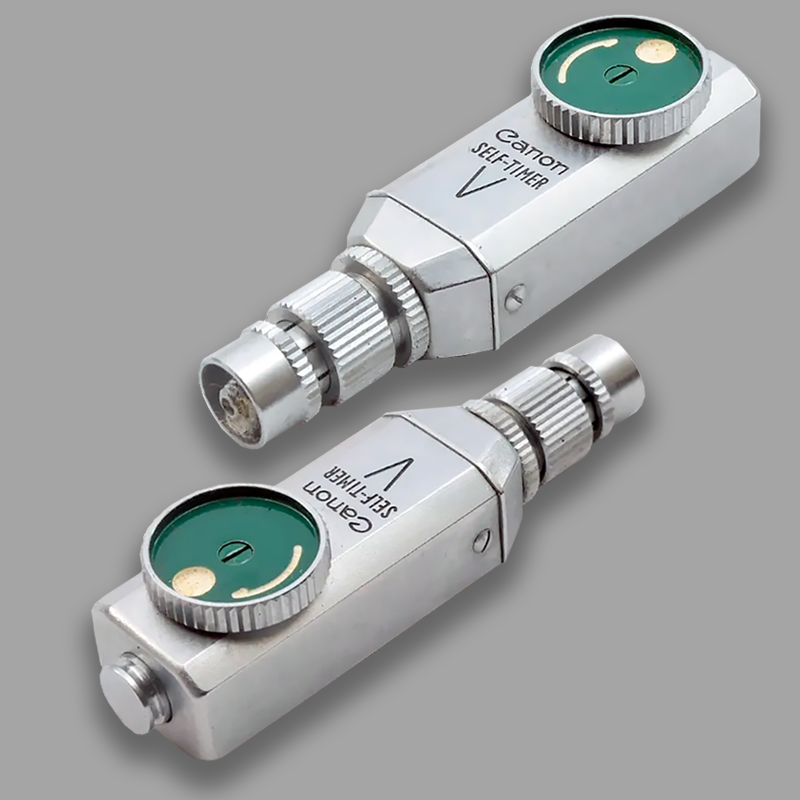
Canon Self-Timer #IV and #V
#IV was an adapted self-timer #II; It was replaced after a few weeks.
#V The Canon Self Timer V replaced the Self Timer #IV and is almost identical to self-timer #III; this model has a Compur-thread and an “V” on the front.
- Year of Introduction: #IV – 1957
- Year of Introduction: #V – 1957
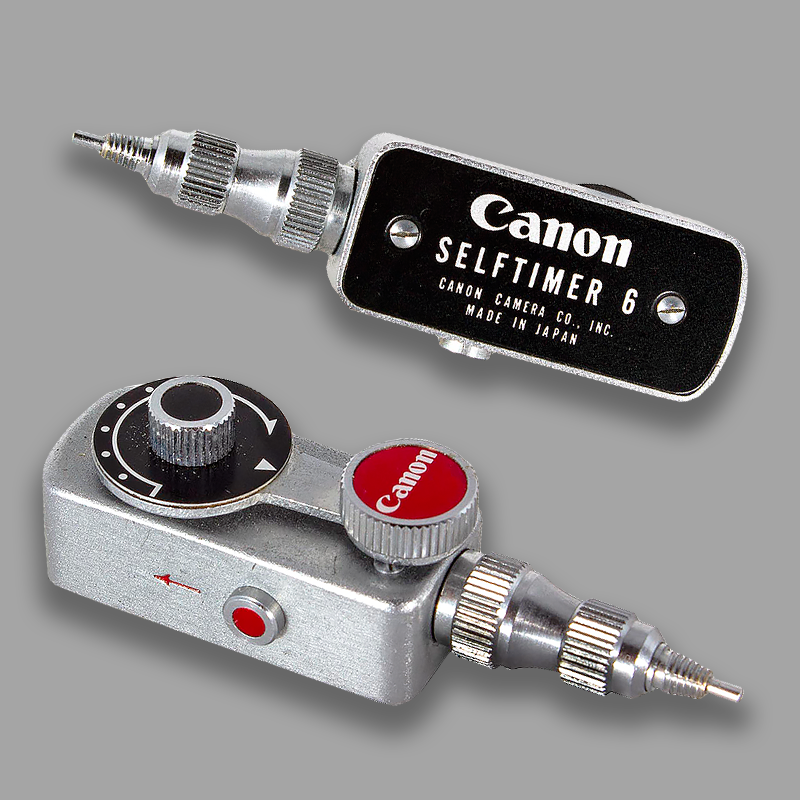
Canon Self-Timer #6
The Canon Self-Timer #6 has a Compur-thread, is matt chrome-plated and has a black scale for the lead time and a red signal dot with the inscription ‘Canon’.
For the first time Canon used Arabic numerals instead of Roman numerals.
- Year of Introduction: #6 – 1963
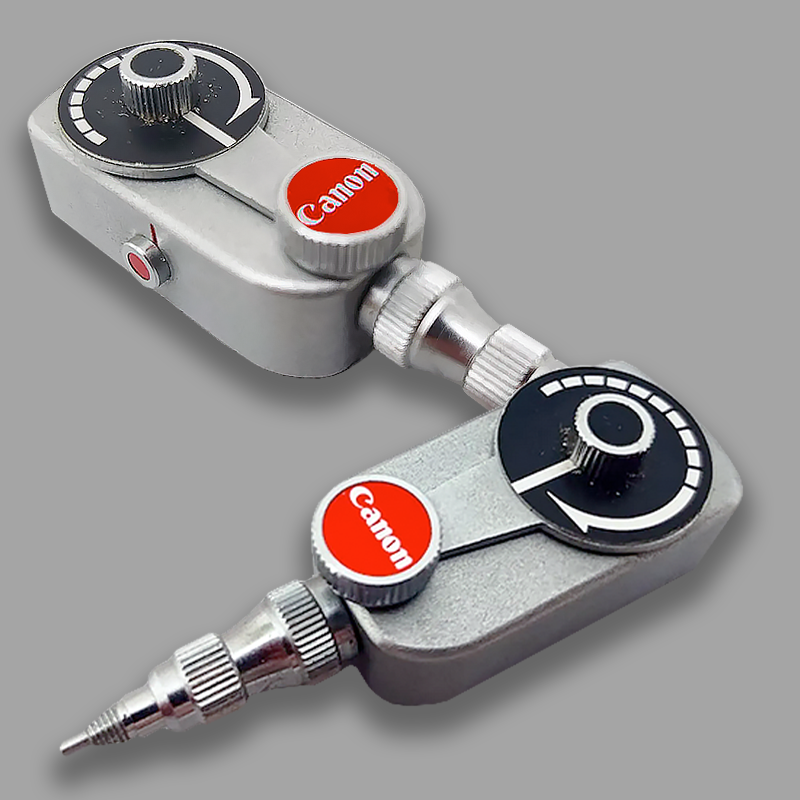
Canon Self-Timer #7
The Canon Self Timer #7 is very similar, but slightly wider than its predecessor.
It was a special accessory for the Canon TL, a slimmed-down version of the Canon FT QL SLR camera that required a particularly powerful self-timer, stronger than #6.
- Year of Introduction: #7 – 1968
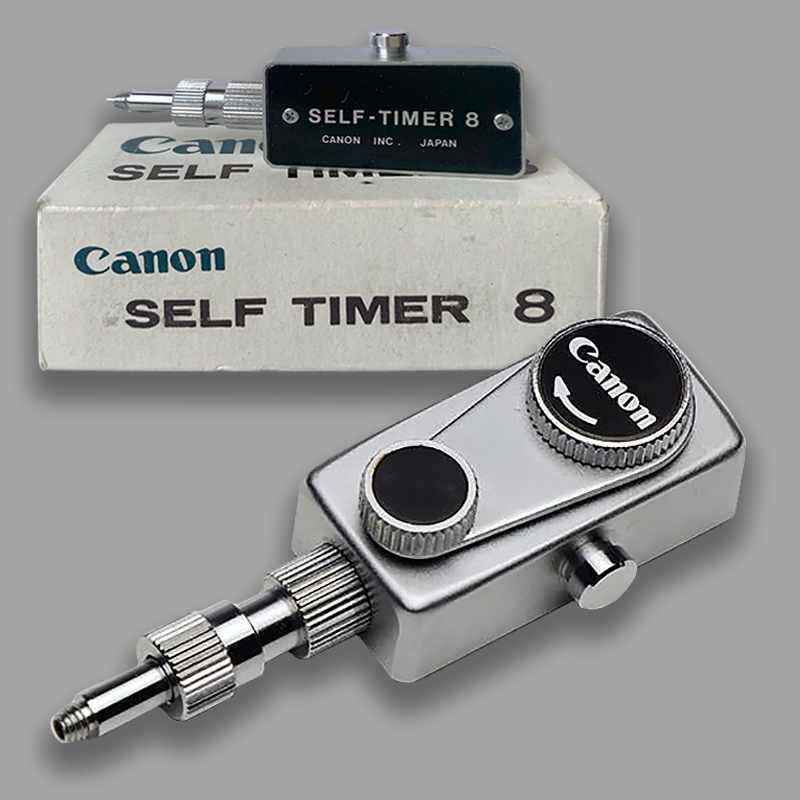
Canon Self-Timer #8
Canon’s last mechanical self-timer #8 was released in May 1974. It replaced the Model #6.
It has a Compur-thread, is matt chrome-plated and has a start button on the side and a black signal dot.
- Year of Introduction: #8 – 1974

